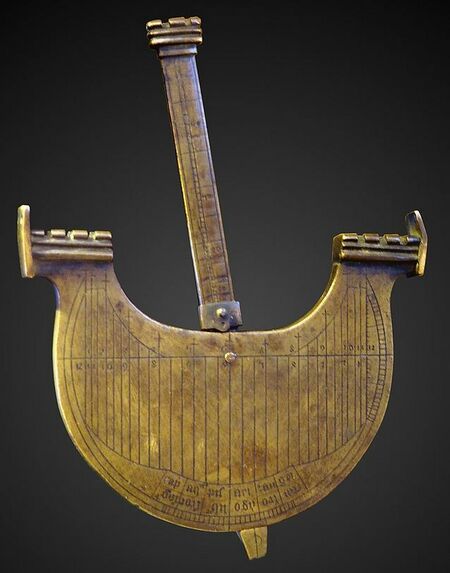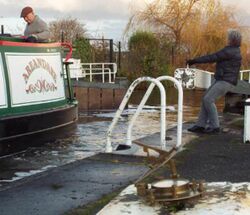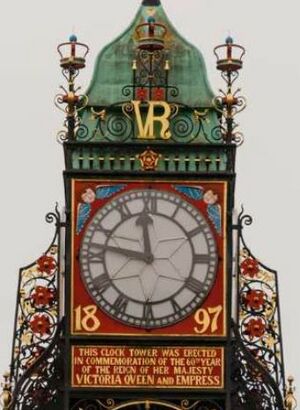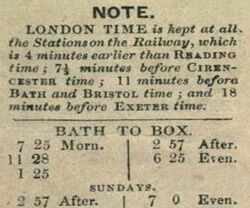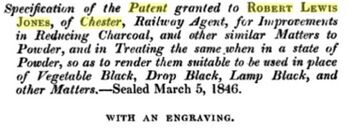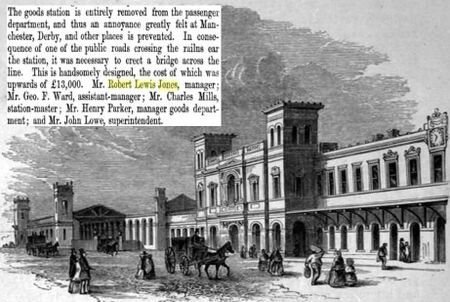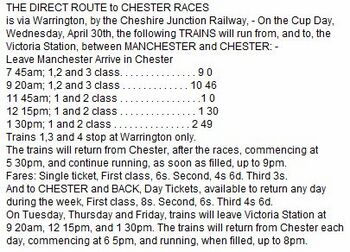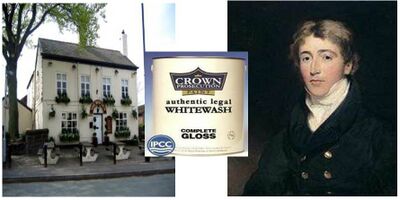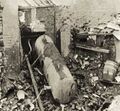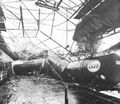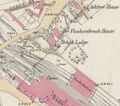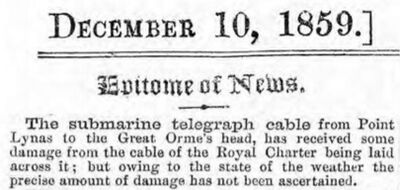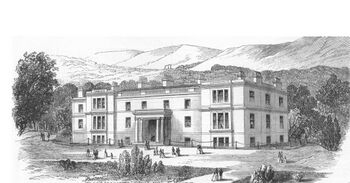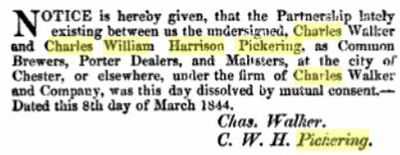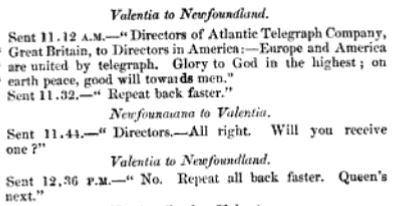Time
This is a story about time. It features a host of Victorian eccentrics and leads a winding path from Chemistry Lock via Chester Station and Hilbre Island to the Trans-Altantic Cable. To sum it up, there are two threads to the tale: on the one hand the story of Robert Lewis Jones, Station Manager at Chester, and on the other that of Hilbre Island.
Time and the Sun
People have used the sun to tell the time of day for millennia. At times with the day and night each divided into twelve hours. The Egyptians went so far as to describe the underworld in the "Amduat" as the "twelve hours of the night". These hours were unequal, depending on the season. In medieval Europe, the Roman hours continued to be marked on sundials but the more important units of time were the canonical hours of the Orthodox and Catholic Church. During daylight, these followed the pattern set by the three-hour bells of the Roman markets, which were succeeded by the bells of local churches and monasteries. They rang prime (the first hour) at about 6 am, terce (the third hour) at about 9 am, sext (the sixth hour) at noon, nones (the ninth hour) at about 3 pm, and vespers at either 6 pm or sunset. Matins and lauds precede these irregularly in the morning hours; compline follows them irregularly before sleep; and the midnight office follows that.
The Venerable Bede is reported to have instructed his followers in the art of telling time by interpreting their shadow lengths. However, Bede's important association with sundials is that he encouraged the use of canonical sundials to fix the times of prayers. Bede had a serious interest in time: his "On the Reckoning of Time" (De temporum ratione) included an introduction to the traditional ancient and medieval view of the cosmos, including an explanation of how the spherical earth (he knew it was not flat) influenced the changing length of daylight, of how the seasonal motion of the Sun and Moon influenced the changing appearance of the new moon at evening twilight. Bede also records the effect of the moon on tides. He shows that the twice-daily timing of tides is related to the Moon and that the lunar monthly cycle of spring and neap tides is also related to the Moon's position. He goes on to note that the times of tides vary along the same coast and that the water movements cause low tide at one place when there is high tide elsewhere. Since the focus of his book was the computus, Bede gave instructions for computing the date of Easter from the date of the Paschal full moon, for calculating the motion of the Sun and Moon through the zodiac, and for many other calculations related to the calendar. Bede's almost obsession with time and dates probably coloured his view of the reasons for the historical Battle of Chester - which he in part puts down to a disagreement over the date of Easter.
In higher latitudes the length of daylight in the summer and the winter months differ signifcantly and dawn or dusk form a poor basis for any systematic time. Noon is a far better choice, as it can always be taken as the middle of the day. Astronomers still use "Julian Days" (or "Astronomical days") which run from noon to noon rather than midnight to midnight ("solar" or "siderial") days. Determining noon is simple, if the sun is visible, it is when the sun is highest in the sky above the horizon and the shadow of a suitably placed stick is shortest. In the northern hemisphere it is also when the shadow points true north. A sundial is effectievely a fixed stick (gnomon) which casts a shadow on a plate (dial) marked off in hours. The earliest sundials known from the archaeological record are shadow clocks (1500 BC or BCE) from ancient Egyptian astronomy and Babylonian astronomy. The oldest known sundial is an egyptian "shadow clock" made from green schist from the time of Thutmose III. Presumably, humans were telling time from shadow-lengths at an even earlier date. The Roman writer Vitruvius (born 80-70 BC) lists dials and shadow clocks known at that time in his "De architectura" (c. 25 BC), so their were almost certainly sundials in Roman Chester. In fact the Romans appear to have imported the sundial from Sicily in about 263 BC. Roman Timekeeping had a period from sunrise to sunset divided into twelve hours, with the night divided into four watches whose passage was tracked by the use of water clocks.

It is self evident that with a small sundial the time can only be estimated roughly. For more accurate estimates the simplest solution is to build a larger sundial, but any sundial also needs to be aligned properly. The "gnomon" (which was known earlier but appeared in Europe by 1500) should point at the Pole Star and the dial should be flat. Many "garden" sundials lack these basic features. The sundial shown in the image on the left is the worlds largest stone sundial, accurate to 2 seconds. The "Vrihat Samrat Yantra", which means the "great king of instruments", is 88 feet (27 m) high; its shadow tells the time of day. Its face is angled at 27 degrees, the latitude of Jaipur, where it is located – so it points, as does any sundial at Polaris. The Hindu chhatri (small cupola) on top is used as a platform for announcing eclipses and the arrival of monsoons. The shadow moves the width of a human hand in a minute. Portable "scientific instrument" sundials are quite common as curiousities although many are reproductions made in India. They are usually made of brass and typically feature a magnetic compass to align the instrument, leveling screws and bubble levels to get it flat, and both a gnomon and a dial which can be set to the correct latitude. On a clear day they can be used to determine the instant of noon within a few minutes. During the Renaissance period the development of sundials proceeded rapidly and many varied and ingenious designs were produced. In addition to having hour and minute marks for telling the time, other features were often incorporated to indicate the seasons, the calendar date, times of sunrise and sunset and the points of the compass. However, sundials were gradually superseded by clocks (though the French railways regulated their clocks by sundials right up to the end of the 19th century, with the last stations abandoning the sundial in 1900). A sundial was even included on the NASA Mars rover as a back-up navigation device - knowing the time of Martian day the shadow direction alows the orientation of the rover to be determined if all else fails.
Time at Chester
Chester has few notable sundials. St Mary on the Hill has a sundial probably dating to the 18th Century with a copper dial and a slightly damaged gnomon. However there is a little known connection between Chester and early time-keeping. The "navicula" was a medieval instrument used to estimate the time at sea and which was shaped like a little ship. The cursor (with a plumb line attached) was slid up/down the "mast" to the correct latitude. The user then sighted the sun through the pair of sighting holes at either end of the "ship's deck". The plumb line then marked what hour of the day it was. It is related to the sextant. One of the surviving manuscripts relating to the "navicula" has been linked to the Austin friary at Warrington and mentions Chester as a specific place. The document shows characteristic signs of Chester dialect and contains references to Chaucer's "Treatise on the Astrolabe". Whether Chaucer (c. 1340s – 25 October 1400's) was actually the author of the treatise on astrolables has been the subject of some debate and it now believed that this was the work of John Westwyk, another monk who based his work on Arab technology.
It is possible that Chester may have been a medieval center of mathematical knowledge given that it was the home of Robert of Chester who worked in the 12th Century and translated several important works from Arabic into Latin, including several work on mathematics. Among his writings are a treatise on the astrolabe (written in London in 1147). Robert of Chester is known to have wriiten other works on navigation and timekeeping which have been lost. He is also known to have written works on "alchemy", particularly on pigments and inks.
Chester's "master clock" appears to have been that at St Peter by the High Cross. This is discussed in greater detail under Clockmakers. The actual agreement for the provision of clock is recorded in Chester "Assembley Order 492" of 1585:
- "Whereas William Sampsoune clockmaker exhibiteth his bill to be free of this citie in consideracon to make a clock and orderly and substantial chymes in the Parish Church of St. Peter th'appostle within the said Cittie with a dyall streetwards there to dicerne the houres and tymes of the day upon his own charges (having found to him all carpenters' work, ropes, piece and iron) which being waied and considered it is news fully agreed upon by the said Maior etc. That the saide Sampson After that he shall have fully made the saide clock, chymes and dyall in sorte as before shall be enfranchised and made free gratis in consideracon thereof."
The church clock at St Peter was at one time provided with "Jacks", animated wooden figures who rang a bell on the quarter hours. These were paid for (1612) by Robert Amerye, a Chester ironmonger who is otherwise noted for putting on the play "Chester's Prince" in 1610. Accuracy to 15 minutes was pretty good going as few clocks could achieve this. Most church clocks at the time only had a single hour hand (one such clock still survives at St Lawrence, Stoak). It is perhaps not a co-incidence that the church clock at St Peter was installed quite soon after the dissolution of the monasteries. Prior to this the monastery bells would have provided the time of day. The public mechanical clock and the movable type printing press were two of the most important and complex "general purpose" technologies of the late medieval period. The argument has been made that public clocks helped regulate economic activity and therefore improve efficiency. For example parties could agree to meet at a specific time. Both time-keeping and the duplication of knowledge may well have been mainly the province of monks and friars prior to the Reformation, which moved these functions into secular hands. It may be no coincidence that that the Reformation was followed by growth in both the number of public clocks and printing presses. For more on the history of printing in Chester, see Bookseller.
Time at Sea

Knowing the time is essential for accurate navigation at sea, especially when out of sight of land. With a compass alone it is possible to determine direction and the maximum altitude of the sun on any given date can be used to determine how far north or south one has sailed - if the sun is more or less directly overhead at its highest then the ship is on or near the equator. Determining the distance east or west is more complicated as this needs an accurate clock so that local noon time can be compared with time at "home". Unfortunately, early clocks did not work well at sea, as the bobbing of a ship would disturb the action of any pendulum and other escapements fared little better. Accurate naval clocks were first developed in the 18th century, and were a major technical achievement. They were largely the work on one man: John Harrison. Harrison's solution revolutionized navigation and greatly increased the safety of long-distance sea travel. The problem he solved was considered so important following the Scilly naval disaster of 22nd October 1707 that the British Parliament offered financial rewards of up to £20,000 (equivalent to £3.17 million in 2020) under the 1714 Longitude Act. In 1730, Harrison presented his first design, and worked over many years on improved designs, making several advances in time-keeping technology, finally turning to what were called sea watches. Harrison gained support from the Longitude Board in building and testing his designs. Toward the end of his life, he received recognition and a reward from Parliament. Somewhat surprisingly, the other great standby of navigation, the sextant only begcame well known in an early form about 1731, although early reflecting instruments were proposed by scientists such as Robert Hooke and Isaac Newton. Before ships clocks became widely available and affordable, methods of telling the time at sea developed into such elaborate methods as very accurate measurement of the position of the moon or even attempts to use the moons of jupiter.
Time on a sundial and time on a watch are not the same. This is due to the fact that the earth does not orbit the sun in a perfect circle and the fact that the earth is tilted relative to its orbit around the sun. Apparent time, and the sundial, can be ahead (fast) of an accurate clock by as much as 16 min 33 s (around 3 November), or behind (slow) by as much as 14 min 6 s (around 11 February). The "equation of time" relates sundial time to watch time and has zeros near 15 April, 13 June, 1 September, and 25 December (when both agree), but even these vary due to leap years.
A measurement of the noon position of the sun might only be approximate and clock time can be up to about 15 minutes out as regards solar time. The photo of the Eastgate clock was taken at “noon” solar time (as a sundial would measure it). At major ports a more accurate measurement of “noon” was made using special "transit" telescopes to determine when the sun was due south at the port in question. Dr. Harold Whichello, an amateur astronomer from Tattenhall was still bemoaning the lack of accuracy of church clocks in 1900:
- "In the country, especially if remote from the rail, it is always difficult to find the right time. In this village the church clock is always wrong. Having no transit instrument, I have often thought of setting up a sundial by which to correct my clocks once or twice a week."
In fact, Tattenhall St Alban's church has a sundial inscribed with the date 1822, and the names of churchwardens - "Joseph Cheers, Thomas Boot, CW". Other local church sundial remains include that at St Oswald's Backford (1832), and those at Stoak and Shotwick. Others, such as that at Barrow (dated 1705) have dissappeared. Many later churches, especially those built after the railways did not have a clock at all and donating clocks to these "new" churches became popular amongst the Victorian rich. In Chester, Charles Brown left money for the clock at Hoole (Chester) parish church as recorded in the Courant (6th July 1904):
- "The vestry of All Saints', Hoole, discharged the agreeable duty on Wednesday of accepting with hearty thanks the generous offer of a clock from the executors of'the late Mr. Charles Brown, and granting permission for the erection. This is, of course, subject to the decree of the Consistory Court, where at the end of the month a faculty will be applied for. The clock is to be erected in the belfry, and will be constructed with a view to illumination at some future date. There will be three dials or faces of white opal, and the clock will strike the hours and chime the quarters. Tho gift will, to use a familiar and expressive phrase, supply a long-felt want in the parish. It is satisfactory to learn that the vestry decided to also apply for permission to put a brass tablet in the church recording the gift."
For many years Liverpool had an observatory on the current site of the Waterloo docks. The Bidston Observatory was built in 1866 when Liverpool Observatory had to relocate due to the expansion of Waterloo Docks. It was built alongside Bidston Lighthouse and Signals Station, on land owned by the Mersey Docks and Harbour Board. George Fosbery Lyster was the architect. John Hartnup, astronomer and Assistant Secretary to the Royal Astronomical Society, had been the Director of Liverpool Observatory since it was built in 1843. Amongst his achievements was the calculation of the longitude of Liverpool, which was important for navigation and the development of the port. He presided over the move to Bidston Hill, and continued as director of Bidston Observatory until his retirement in 1885, when he was succeeded by his son. The second director, John Hartnup Jr died on 21 April 1892, when he fell from the roof of the Observatory while making meteorological observations.
The Observatory’s two levels of cellars and other features made it especially suited for calibrating chronometers under controlled conditions of temperature and seismic vibrations. Mariners sent their chronometers from all over the empire for calibration at Bidston. In 1929 the Tidal Institute was amalgamated with the observatory. Under the direction of Joseph Proudman, Arthur Doodson became the leading authority on tidal predictions and built mechanical computers to calculate tidal timings. Bidston Observatory was deemed of national importance during the Second World War and predicted the tides for the D-Day landings, using one of Doodson's mechanical computers.
The exact time was needed for nautical navigation and was transferred to ships in the docks at Liverpool by the firing of the "one o’clock gun"; the gun was fired for the last time on the 18th of July 1969. The gun was triggered electrically by a specially adapted Robert Molyneux clock. At 12.30pm each working day a member of staff tested the connection between the clock at the Observatory and the cannon. At one second to one o'clock the switch would be thrown at the Observatory, the firing being triggered by the next swing of the clock's pendulum. Molyneux was a noted nautical and astronomical clockmaker. His 1843 clock for the Liverpool observatory was fitted with electrical contacts in 1856 to enable remote control and is now on display in the Liverpool World Museum.
It is not known how mariners set their clocks at Chester, or any of it's out-ports such as Neston and Parkgate. Given that the port had entered a serious decline at an early date and it's trade was mostly coastal, it is unlikely that there was ever any inclination to establish special time-keeping measures such as an observatory at Chester.
Railway Time
Before the arrival of the railways, road or perhaps canal journeys between the larger cities and towns could take many hours or days, and the local time differences could be dealt with by adjusting the hands of a watch periodically en route - there were even stagecoach drivers watches which could be calibrated to gain or lose time. People simply lived with the fact that time could typically not be accurately determined within about a quarter hour. Even simply allowing for the east-west difference, 12 noon at Greenwich, was 12.05 in Dover, 11:48 in Liverpool, and 11:43 in Plymouth. In Britain, the coaching companies published schedules providing details of the corrections required, but these "time bills" appear to have been for internal use rather than for the public.
With the coming of the railways the local time was at first widely used as the basis for time - the original Liverpool Road station in Manchester had a sundial mounted on the wall as a timekeeper. Eventually station-masters adjusted their clocks using tables supplied by the railway company to convert local time to London Time. When Brunel announced that the clocks on Bristol Temple Meads station would be set to London time, there was outrage and many complaints that people keeping Bristol time would miss their trains. The clock on the Corn Exchange in Bristol therefore has two hands, one for “railway time” (now GMT) and the other for Bristol time.
Time was at first transmitted using various means over the local rail network, often with one pocketwatch being set off another. Some of these watches (now extremely rare) could actually be locked to avoid tampering. By the time the information reached a signalman at an isolated box there were all sorts of errors which could have added up – errors in reading, setting and maintaining an accurate time. To add to the confusion, local time varied from place to place. This is on top of the all the sources of error discussed above. Railway timetables advised how train departure and arrival times might vary from local times – by as much as over 15 minutes. Some watches could be set to gain or lose time depending or the direction being taken and therefore roughly correspond with local time. There were some strange hold-overs until 1848 the Chester and Holyhead Railway persisted in taking its time from the signal gun at Craig-y-Don in Llandudno - sixteen and a half minutes later than the London Time used by the lines to which it connected at Chester.
Obviously, there are circumstances on a railway when you might want to ensure that two trains are not trying to use the same length of track at the same time, especially when a faster express needs to overtake a slower stopping train. The Great Western Railway was the first to standardise its timetable on Greenwich Mean Time, in November 1840. By 1845 the Minutes of the Proceedings of the Institution of Civil Engineers (Volume 4 Issue 1845, 1845, pp. 71-77) were proposing the use of telegraphy to transmit railway time:
- "Mr. WHISHAW was of opinion, that the plan of marking different times on the same dial would create confusion, and that it would be better, that Greenwich mean time should be adopted for ordinary purposes throughout the kingdom. Four years ago he proposed, that by means of the electric telegraph, all the clocks along the line of a railway should be regulated to similar time."
One of the most vociferous proponents of standardising time on the railways was Henry Booth, Secretary of the Liverpool and Manchester Railway, who by January 1846 had ordered the adjustment of clocks to Greenwich Mean Time at both Liverpool and Manchester stations. On 22 September 1847, the Railway Clearing House, set up five years earlier to coordinate the distribution of revenue between railway companies, decreed that "GMT be adopted at all stations as soon as the General Post Office permitted it". From 1 December 1847, the London and North Western and the Caledonian Railways switched over. By January 1848, according to Bradshaws Railway Guide, the railways that had adopted London Time included the London and South Western, the Midland, the Chester and Birkenhead, the Lancaster and Carlisle, the East Lancashire and the York and North Midland.
However, there was still one weakness in the system, unless the local time was accurate the station clocks would not be set accurately, and as noted above this time had to distributed to others. In the case of the Irish Mail, a specially set watch would be delivered to Euston each day by an Admiralty Messenger, taken to Dublin and then brought back by return ferry and train. The Irish Mail went to Holyhead by train for the first time on August 1 1848, and on the same day the present Chester Station was opened, replacing the separate stations previously used by Crewe and Birkenhead services.
The story now splits into two threasds. One in Chester the other in Liverpool, both are concerned with travel, time and communication and while the stories start quite separeately, they come together in the due course of time.
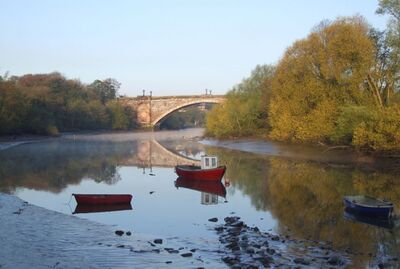
Robert Lewis Jones: the first thread
Chester was once a thriving port. Much of its industry was associated with the leather trade and associated crafts, such as boot making. The Tanners had foremost place in the Chester Mystery Plays, although the reasons for the ordering and assignment of the Plays with regard to the guilds are not entirely clear. The position of the actual port shifted over time, moving progressively downriver as the River Dee silted and sometimes returning to the Portpool as attempts were made to improve navigation.
The Industrial Revolution largely passed by Chester. In the late 18th and early 19th century Chester was not a propitious place in which to establish new industries. It was not on a coalfield, and water power was restricted to the weir on the Dee, which was affected by the tide. The hinterland was mainly rural and was poorly served by transport. There seems also to have been a lack of enterprise on the part of Cestrians, and the residual power of the city guilds may have restrained development. It was observed in 1814 that:
- "corporate privileges are not often calculated to foster commerce, and in this city, although we mark the infancy of several manufactures, few arrive at maturity" (Wardle and Bentham's Commercial Guide, 1814).
The influence of the guilds did not ebb as quickly as in other towns, due mainly to their subvention by the Owen Jones charity. Their final decay came about in part because of restrictions on membership imposed in order to maximize existing members' benefits from the charity, but their authority was destroyed finally in 1825 when an unsuccessful case was brought against a tanner for trading when not a freeman.
Fenwick would comment on the effect of the Industrial Revolution on Chester:
- "..for a long time [Chester] lay almost motionless upon the great tidal wave of progress which was sweeping past, but at length a movement became apparent, and even ancient Chester.. ..could no longer withstand the onward rush of events. The turning point dates from the accession of Queen Victoria." (A History of the Ancient City of Chester, 1896)
Jones the Chemist
Chester was already failing as a port before the railways arrived. The Portpool was still active in the shipment of Cheshire Cheese but the linen trade had collapsed.

Tanning wss still a major industry in Chester, but there is a shortage of oak-bark to use in the process as Delamere forest has been over-worked. Alternative materials are explored and this leads to the construction of a very noxious chemical works by the River Dee. On 13th August 1812 the North Wales Gazette reported:
- "Mr. Andrew Patten, of Manchester, has obtained a patent for a discovery in Tanning Leather, by the use of Pyroligneous, or Wood-acid. The process is as follows. The hides to be tanned are to be first limed, haired, fleshed, aud beamed, in the manner in general used by tanners after which they are to be well washed, and cleared of the lime and masterings, and then immersed into a pit of weak liquor made from oak bark, in which they must remain for five or six weeks, and he handled well till they begin to bloom then they are to be taken out and immersed into a pit of pyroligueous acid for about a fortnight, more or less, according to the substances of the hides. Before the pyroligneous acid is put into the pit it must be well filtered, or cleared from the oily or tarry matter — In order to bring the hides as nearly as possible to the colour which is generally given to leather, they should be removed into a pit of strong ooze, or bark liquor, and be suffered to remain there for three or four weeks or they may be put into two such leys three or four weeks, then they may be taken up and dried for sale — if the hides are very heavy they must lie longer in the acid and in the bark liquor."
Further information on this process is given in The Medical and Physical Journal, Volume 28. Andrew Patten's co-inventor was Charles Hankinson of Chester - who gives the occupation of Tanner in the patent. Pigot's Directory of Chester lists three pyroligneous acid manufacturers: Gaman & Palin of Stone Bridge, Thomas Jones of Tarvin Lane and George Topham of "Botany Bay" (on the Canalside between Cow Lane bridge and Queen Street).
The noxious chemical works by the Castle was eventually closed, but not before it was recorded by the painter Francis Nicholson. Chemistry Lock on the Canalside in Boughton was built c1773 by Samuel Weston (active 1768-1804) for the Chester Canal Company and named after the former chemical factory which stood nearby which, acording to some accounts, produced naphtha. Other sources have the factory producing materials for the leather tanning industry such as "gallic acid" or "tannic acid" from oak-galls or "oak-apples". Oak galls are balls of bark and the excretions of wasps. They host wasp larva, and grow when a gall wasp (fam. Cynipidae) punctures an oak tree and deposits their larva into the hole. This causes the tree to secrete tannic and gallic acids (English oak galls comprise 15 to 20 per cent of gallotannic acid), creating a spherical gall nut, oak gall, or oak apple. They typically have a hole where the wasp larva pokes its way through to escape.
Robert Lewis Jones appears to have inherited the works from his father Thomas (he had a brother of the same name). Robert lived in Tarvin Road according to the census data and the tithe maps show his ownership and use of the site by the canal. He would eventually sell the business to Major and Turner – who later moved to Saltney. One of the processes which Jones used was the “dry distillation” of oak galls. This drives off various gasses which are collected and from which useful chemicals can be made. These include materials useful for tanning leather, making inks etc. Heating up wood to drive off inflammable vapours (including methanol - which was then known as "wood alcohol") in a big vessel can be dangerous. The picture on the left shows the aftermath of a boiler explosion elsewhere, but we know that there were fires and even deaths at Chemistry Lock. Phil Cook provides the following additional information:
- "Gordon Emery, in ‘The Old Chester Canal-A History and Guide’, records the change of name in 1810, when Mr Jones of ‘the chemistry’ was instructed to lay no more soil on the towing path. In 1807 he had been granted permission to take cooling water from the canal for his steam engine, on condition that cinders from the engine be used to repair the tow path, and that he paid an annual rent of two guineas. Mr Jones, proprietor of the Gallic Acid Works near the Spittlefields, appeared on the Tithe Map for Great Boughton, on a site 80 yards east of the lock. The small chemical works probably used oak galls and bark to make the acid which was used in tanning. The name Chemistry Lock had become officially associated with this lock by 1856. The Canal Company appointed Samuel Dunning as the lock keeper, Hoole Lane and Chemistry Locks. Major and Co., listed as manufacturing chemists here, may well have taken over from Robert Lewis Jones, but after fires in 1845, 1852 and 1861, when the walls were ‘Much shaken such that the building will have to be erected afresh’, the works were transferred to Queensferry and eventually became part of the Midland Tar distillers."
Jones may well have thought that working on the railway would be a safer option. The picture in the gallery below shows this is not always the case – curiously, the train in question had recently passed Chemistry Lock and one of the drivers was named Jones!
Jones filed a patent on the work he had done at Chemistry Lock, but by the time the patent was granted he had already moved to a job with the railway. The patent records for 1846 list a patent to:
- Robert Lewis Jones of Chester, railway agent, for improvements in reducing charcoal and similar matters to powder aud in treating same when in a state of powder so as to them suitable to be used in place of vegetable black, drop black, lamp black and other matters: March 5 six months.
By the 1830's traditional manufacturing trades, including the making of clay-pipes, clocks and gloves in Chester were in serious decline, if not entirely extinct. Ship-building was entering a terminal phase and rope-making barely survived. Both of the two cotton mills had closed by the 1820's, so one of the leading industries of the Industrial Revolution had failed to establish itself in Chester. While in the 18thC. the City Fair's had been dominated by linen (the trade peaked in the 1760's), by 1830 the trade was dead. The reasons for the collapse of the linen trade center around the decline in the Chester/Dublin sea-trade route, as its ends moved from Dublin to Belfast and Chester to Liverpool, as well as the substitution of cheaper cotton for linen. George Lee Fenwick commented:
- "..for a long time [Chester] lay almost motionless upon the great tidal wave of progress which was sweeping past, but at length a movement became apparent, and even ancient Chester.. ..could no longer withstand the onward rush of events. The turning point dates from the accession of Queen Victoria." (A History of the Ancient City of Chester, 1896)
The railways saved Chester, but soon brought about the first railway disaster that Jones would experience.
Chester Station
During the late 1830's there was much discussion of the possible route of an improved rail and sea communication with Dublin. With the passing of the Act of Union in 1800, creating the United Kingdom of Great Britain and Ireland, recently elected Irish members of the new United Kingdom Parliament sought the same quality of travel and postal facilities as their fellow members from England, Wales and Scotland. Improvements continued slowly, and by the time Thomas Telford had completed his A5 road with improvements through Shrewsbury, Llangollen, Betws-y-coed, Bangor and his Menai Suspension Bridge in 1826, the London to Holyhead journey by road and ship was down to under 30 hours. Chester's Grosvenor Bridge was to a large part a response to Telford's A5 route and the percieved threat to the historic Irish trade in Chester.
The proposed, competing routes were:
- By rail from London to Chester (via Rugby), and then onwards by rail through Flint, Conway and Bangor to Holyhead, where the small existing port would need improvement. Apart from a few short sections (near the Great Orme, for example) the railway would run along a flat coastal strip from Chester to Bangor, and few tunnels would be needed.
- By rail from London to Shrewsbury, and thence up the valley of the upper River Dee and through hills and mountains to Llangollen, Corwen, Bala, Barmouth, Portmadoc and Portdinllaen (near Nefyn). From the latter there would be a sea-crossing to Dublin. While a shorter rail route, this would have been the most expensive to build. A similar railway line was later built, but only survives in part today. The great advocate of Porth Dinllaen was Henry Archer, Secretary of the Ffestiniog Railway Company, who engaged the services of Charles Vignoles to survey the route in 1835, although Vignoles produced three alternative routes.
- London to Liverpool by rail, and then by sea to Dublin. This would have involved the longest sea-crossing.
- Via Gloucester and New Quay in Cardigan Bay - a route favoured by Brunel.
Fortunately for Chester, the route chosen was that along the north Wales coast.
Chester's historic Station is one of only twenty-two Grade I and Grade II* listed railway stations in the whole of England and one of only three in the northwest region (the others being Carlisle and Edge Hill, Liverpool). An old guidebook describes the Station as follows:
- "Let us first inspect our commodious and convenient STATION. It is situated in Flookersbrook at one extremity of the borough although the suburbs of the town extend much further. The Chester Railway Station presents a noble pile of buildings in the Italian style remarkable for its beauty and grandeur of proportions it is the longest of all the railway stations in England. It is admirably adapted for the purpose of developing all these facilities and conveniences which are the characteristics of the railway system and forms the grand central terminus of all the lines meeting in Chester viz the London and North Western the Chester and Holyhead the Great Western and Birkenhead Lancashire and Cheshire Junction Railway Companies. The station consists of a facade facing the city of Chester 1050 feet long built of dark coloured bricks with dark facings and dressings. The centre of this building which is two stories high contains on the ground floor the usual offices, waiting and refreshment rooms and in the upper story are the offices for the general manager and for the Chester and Holyhead and Great Western companies in which the business connected with the lines is conducted. The number of offices and rooms exceeds fifty. The wings are formed by projecting arcades with iron roofs and are appropriated to private and public vehicles awaiting the arrival of trains. On the inner side of the office buildings a large platform extends which is chiefly used for departing trains and is 750 feet long; this and three lines of railway are covered by an iron roof sixty feet span, which is most elegantly designed; behind this shed, and only divided from it by a series of pillars and arches, is another shed for passenger trains, 450 feet long by 52 feet wide also covered by a beautifully constructed iron roof. The length of line immediately connected with the passenger station is about 15,000 feet, with 36 turn tables and numerous points and crossings."
If you ask a Cestrian what is above the main entrance of Chester Station, they will probably say a clock. However, the clock is actually offset so as to be visible down the length of City Road, at one end of which stands the Station. It was originally located in the centre of the building, where the British Rail logo is now but, when the Queen Hotel opposite was built in the 1860s, it obscured the view of the clock from City Road and it was subsequently moved to its present, rather ungainly, position. The clock plays a major part in this story, but more of that later. The frontage of the station was designed by Francis Thompson.
From 1841 to 1871 Chester enjoyed thirty economic boom years. The main evidence for this is the extent of migration to the city and population growth, but prosperity was also reflected in a large rise in the number of businesses and in the amount of rebuilding in the city centre. The arrival of the railways reasserted Chester's importance for transport and consolidated its function as a service centre for the region. A limited growth in manufacturing further diversified the economy. In choosing their route through the City, and given the main imperative of creating efficient communication with Ireland through the new port of Holyhead, the railway avoided the City Centre, locating the station in an outlying area of marshy land known as Flookersbrook after the stream that ran through it. The land was occupied only by market gardens and a single row of cottages. Subsequently other competing companies sought to redress this deficiency by proposing a new line to terminate beside the Cathedral in the Kaleyards. Their thwarted ambitions were represented by a line truncated at the now closed Northgate Station (opened 1875), again located on the periphery of the city above the tunnels of those lines leaving the General Station. Between the two stations lay groupings of engine and goods sheds for the many independent railway companies and the railway colony of Newtown.
Jones the Station Manager
Jones joined the railway company and became Station Manager at Chester Station – here shown with the original position of the station clock (more of the clock later). Robert Lewis Jones joined the railways at about the time of "Railway Mania" - when railway shares were at first thought of as a wonderful investment. You could buy shares for a deposit (of course the company might later come looking for the rest) and the value of the shares soared as company after company was formed and speculation went wild. From 1844 to 1846, an index of railroad company stocks approximately doubled as the speculative mania took hold. The mania reached its zenith in 1846, when 272 Acts of Parliament setting up new railway companies were passed, with the proposed routes totaling 9,500 miles (15,300 km). However, the market index of the railways was already falling.
Jones was working for the railway by the end of 1846. In 1847 he encountered his first rail accident: the noted Dee Bridge Collapse. Robert Stephenson was called upon to design a number of bridges to meet a variety of water-crossing problems on the route of the Chester and Holyhead Railway, a critical link between London and the mail boats from Holyhead to Dublin. Among these was the bridge over the Dee at Chester. In late 1846, the Shrewsbury and Chester Railway, later to become part of the Great Western Railway, first carried traffic. From Saltney Junction, access was gained to Chester via the Chester & Holyhead Railway. This latter line was carried over the River Dee, in the same place where it crosses today, by three 98-foot spans of cast-iron girders resting on stone piers. The design was not unlike that of the Tay Bridge, which collapsed some thirty years later. On 24 May 1847, the driver of the 18:15 Chester-Ruabon train noticed something was amiss as his train, crossing the span of the bridge closest to Saltney, began to vibrate strongly. The driver boldly opened his throttle to clear the bridge and no sooner had he reached the bank than the bridge collapsed into the Dee, carrying away his unfortunate fireman, who was dashed against the stonework of the bridge and killed. The death toll included a guard, two coachmen and a few passengers (sources vary). Sixteen people (sources again vary) were badly injured, which is surprising considering that the whole train, except the engine, fell into the swirling waters of the tidal River Dee.
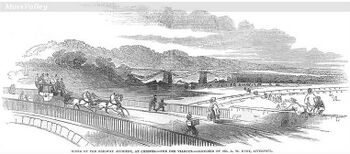
Curiously, Stephenson himself had inspected the bridge for safety earlier on the very same day. He had noted that hot coals falling from passing trains could set the wooden parts of the bridge structure alight and had ordered that the bridge deck be covered with tons of track ballast to prevent the oak beams supporting the track from catching fire. Undoubtedly, this massive loading of the structure with crushed stone contributed to the disaster.
The Official Report by Mr Walker and Captain Lintorn Simmons R.E (inspector of railways). is concerned almost wholly with the bridge, and Stephenson seems to have taken personal control of the situation very quickly. There is no discussion of events at Chester prior to the accident other than that the 6:15 train left a little late at 6:20 that evening. neither Jones nor anyone else at Chester Station is mentioned in the report at all. This makes sense as the joint station was only opened at Chester on 1 August 1848; it cost £55,000 and was to be accessible to the LNWR, Chester and Holyhead Railway, Shrewsbury and Chester Railway, and Birkenhead, Lancashire and Cheshire Junction Railway, and jointly operated. Prior to this there were two separate stations and construction of the joint station only started in August 1847, the station was opened exactly one year later. As noted, the large clock, manufactured by J. B. Joyce & Co on the front of the station was originally located centrally.
While the evidence (or lack of it) points to Jones having no direct involvement in the Dee Bridge disaster, he would be very much aware of it and the subsequent investigations. An inquest started just 10 days after the accident and the report was presented to the inquest on the 18th June. Robert Stephenson came under great pressure, as the evidence suggested that the structure had failed mid girder and was a result of poor design or construction. Stephenson claimed that the train had derailed first and hit the abutment of the bridge which had resulted in the girder breaking. A number of eminent railway engineers supported him, despite the investigation providing no evidence to support the alternative theory.
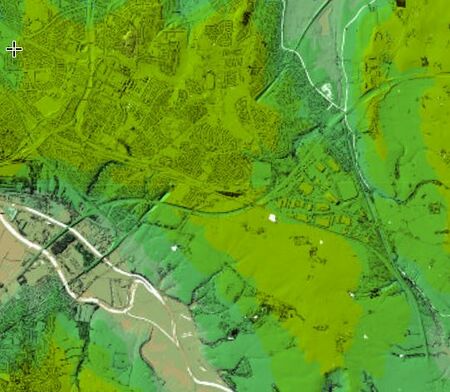
Then came the crash of railway share prices. Companies called in the debts left after the deposits and many went bust. About a third of the railways authorised were never built. Little has been written on whether this bursting of the railway bubble was in part caused by a growing lack of faith following the collapse of bridges and buildings with cast-iron girder construction, including the Dee Bridge (May 1847) but it could have been a partial cause, despite the fact that share prices showed a sharp peak and the beginnings of their plunge in 1846.
The “Hunting of the Snark” (c1875, Lewis Carroll) even pokes fun at railway shares:
- "They sought it with thimbles, they sought it with care; They pursued it with forks and hope; They threatened its life with a railway-share; They charmed it with smiles and soap"
Railway competition now became cut-throat. The Grand Junction Railway had planned a route through Chester to Birekenhead, but went to Liverpool instead. A plan by Mersey ferry-operators to build a railway from Birkenhead to Chester got into problems when the line on to Crewe - the Chester and Crewe Railway - went bust and was bought by the Grand Junction Railway, who then arranged the timetable to make the trip to Liverpool via Birkenhead as inconvenient as possible. Another plan was to link Chester to Lancashire through a railway via Frodsham, but the smaller companies involved had problems raising cash in the aftermath of Railway Mania. Many of the smaller railways were being bought out by the “big few” for much less than the cost of their construction works and the value of their shares. In late 1850 a delayed route from Chester towards Warrington finaly opened. The Chester-Warrington line had been opened by the Birkenhead, Lancashire and Cheshire Junction Railway Company and was built to connect Chester and the manufacturing districts of Lancashire by making a junction near Warrington with the Grand Junction Railway. The BL&CJR had taken over the financially troubled Chester and Birkenhead Railway in 1847, keeping its own name for the combined company. Interests in the Birkenhead docks were aware that they needed a railway connection towards Manchester and the Lancashire manufacturing districts, to enable them to compete with Liverpool. There were also profits to be made by shortening the journey time from Manchester to Chester, for the races, and the new railway would avoid a detour via Crewe and cut the journey time in half. The Birkenhead, Lancashire and Cheshire Junction Railway was incorporated on 26 June 1846 with capital of £1.5 million, to build from Chester to Walton Junction, near Warrington, where it would connect with the Grand Junction line, leading to Manchester. Construction of the Warrington line proceeded, although the shortage of money following the Railway Mania period slowed progress considerably. In October 1850 there was a formal opening, but the actual public opening took place on 18 December 1850. Such were the concerns over money and competition that the directors may have paid little attention to safety.
The line was to have two major engineering projects the first being the 1¼ mile long Sutton Tunnel and the viaduct to cross the Weaver Navigation near Frodsham. The tunnel was duly completed as was the impressive viaduct constructed mainly of brick with cast iron spans. The Sutton Tunnel is 1 mile 154 yards long and is located to the north of Frodsham, to the south of Norton and to the west of Preston Brook villages close to Sutton Weaver. Sutton Tunnel, also sometimes described as Halton Tunnel, is a single bore tunnel that has two tracks. The Sutton Weaver Viaduct ("Bridge Number 54") was designed by James Meadows Rendel, and Thomas Brassey was the Contractor. This segmental-arched cast iron span of 25 metres is approximately 28 metres above the water level of Navigation, with a lower round brick arch to each side surmounted by doubly-recessed rectangular panels.
One puzzle is why a tunnel was needed at all. It is shallower than many railway cuttings. The answer seems to be that Sir Richard Brooke of Norton Priory, didn't like the idea of a railway accross his land. There was nothing new in this sort of objection. During the mid-18th century, Sir Richard Brooke was involved in a campaign to prevent the Bridgewater Canal from being built through his estate. The Bridgewater Canal Extension Act had been passed in 1762, and it made allowances for limited disturbance to the Norton estate. However Sir Richard did not see the necessity for the canal and opposed its passing through his estate. In 1773 the canal was opened from Manchester to Runcorn, except for 1 mile (2 km) across the estate, which meant that goods had to be unloaded and carted around it. Eventually Sir Richard capitulated, and the canal was completed throughout its length by March 1776. During the 19th century the estate was again affected by transport projects. In 1804 the Runcorn to Latchford Canal was opened, replacing the Mersey and Irwell Navigation; this cut off the northern part of the estate, making it only accessible by a bridge. The Grand Junction Railway was built across the estate in 1837. It seems that the Sutton Tunnel was constructed to avoid further objections and delay.
Another unique feature of the line relates to the station at Frodsham which was built in 1850, by the Birkenhead, Lancashire and Cheshire Junction Railway, Due to its early date of construction and the busy use of the station its position was found to be restrictive, it was therefore decided to move the building "En-bloc" away from the railway by 9ft (approx. 3 metres); the station is unique in this respect in having been bodily moved further away from the rails; rather than just being relocated further along the railway which is the usual circumstance however in this case with an embankment at one end and a tunnel at the other it was easier to move the actual station.
Jones was later to be involved personally in the competition between rival railway groups in 1859, when he appeared as a witness before parliament duing arguments about the establishment of the "Cheshire Lines" railway, which was opposed stringently by the London and North Western Railway. While the lesser routes had troubles, the major mail route through Chester to Holyhead soon won back the mail contract from Liverpool. Bradshaw's Guide for March 1850 shows a brisk passenger service on the line: passengers could leave Kingstown at 19:30 Dublin time (25 minutes earlier than GMT) and Holyhead at 01:35 by mail train; the time between Llanfair and Bangor was 35 minutes, although the traveller was not informed that this was by road vehicle; the onward journey arrived at Chester at 04:40 and arrival in London was at 13:00 - a rail journey from Chester to London in a little over eight hours.
A Day at the Races
One of the money-making options for the new “Chester Junction Railway” was to run special trains for the races at Chester. Jones, as Station Manager at Chester, was advised of this by the railway but they did little more than sent him a copy of a “flyer” advertising the trains and noting that the trains would return from Chester "as soon as filled-up". This was the first Cup Day after the railway had opened four months earlier, so there was little experience of what that would mean at Chester station. The result was that 4,000 people arrived at Manchester Victoria Station on Chester Cup Day eager to travel to the races on this new route and there were problems assembling sufficient rolling stock to provide for this unexpected number of customers. All trains started towards Chester late or were delayed en-route. The 7:45am, with 2 locomotives and 38 carriages arrived at Chester at 11:30 (over 2 hours late). It was clear to all that the trains were grossly overloaded - travellers on one train, of 50 carriages, had to get out and walk up an incline because the locomotive was incapable of moving the weight of the passengers.
Despite the unseasonably cold weather on the 30th April 1851, the Roodee was crowded with over 18,000 as never before, many of whom had travelled by train from other starting points (9000 by the old line to Crewe, 5000 from Birkenhead) - whereas Chester Station was only normally used by about 1000 people a day. The big race proved to be one of the most exciting ever seen, with 28 starters: the favourite being a horse called "Rhesus", at 4 to 1. The second favourite was "Italian" and other fancied horses included "Black Docter", "Hesse Hombourg" and "Russborough". After three false starts, they got away at the fourth attempt. Although Rhesus and Italian were always handy throughout the race, Nancy and Black Docter managed to establish themselves at the front. Then, on the run in, Hesse Hombourg and Rhesus put in a strong challenge; but somehow, Nancy and Black Docter managed to stay ahead to the winning post, with Nancy a neck ahead of the "Docter".
The Manchester people left the races smartly as they wanted to make sure they got home, and their experience in the morning would have made them aware of the likely state of the trains. City Road was still a path across the fields, so the crowds would have streamed down Brook Street. By 6pm, the Station Master, one John Critchley, estimated that Chester Station was teeming with some 5,000 people. The first train was immediately filled, with people climbing on the carriage roofs, but they were ordered down "sternly" by Robert Lewis Jones. Trains leaving Chester were overloaded as thousands of race-goers tried to board – possibly after a few drinks and noting the failing weather. Many of the 3rd class were in open trucks, each crammed with about 70 people. A second train left with some 430 passengers. Neither of these first two trains take any other part in the story of what was to come. The three trains which followed were not so lucky.
When the second train departed the crowd surged across the tracks to another standing in a siding and bearing a notice "Manchester via Warrington" on its side. This was quickly filled with some 900 passengers in only 18 small carriages. There was little point in taking the already full train to the platform, so the train left the siding at about 6.50 pm hauled by the locomotive "No. 7 Druid". It was assisted up the Hoole incline from Chester station by another locomotive, "No. 16", driven by David Evans, pushing at the back. "Druid" was apparently a lot less powerful than was believed. The Locomotive Superintendent and his deputy believed that Druid weighed 20 - 21 tons with 8 tons upon the driving wheels but had never seen the engine weighed. When it was weighed at Crewe it was found to weigh 15.1 tons and the weight upon the driving wheels was 5.9 tons: the engine while being weighed was so full of water that the workman declared it to be "past working".
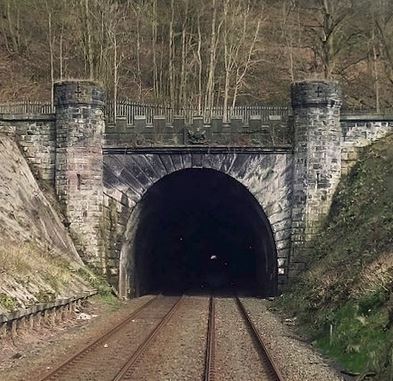
After pushing "Druid" for some distance "No. 16" returned to Chester to collect its own train and the train pulled by "Druid" at first made "good speed" to Frodsham where some passengers left it. Shortly after "Druid" left Chester, it began to rain, and for George Allen, "Druid"'s driver and Thomas Leach, his fireman, on the open footplate, it bacame very uncomfortable, but they were accustomed to this, having both worked on locomotive footplates for a number of years. The rain turned to sleet as the train left Frodsham, and "Druid"'s lighter than believed driving wheels had started to slip. From Frodsham station to the Sutton Weaver Viaduct there is an uphill gradient of 1:240 and the fireman and a local platelayer "sanded" the rails to try and maintain grip. Unfortunately they had no actual sand, and were reduced to using whatever gravel they could scoop up from the trackside (reading between the lines in Laffan's report this appeared to be a quite normal practice). Despite this, the train made only slow progress, even on the level viaduct. It was later calculated that "Druid" took 22 minutes to travel two miles, not much better than walking-pace. Beyond the viaduct the tunnel also had an uphill gradient of 1:264 and it was a desparate struggle to keep the train moving through the increasingly dreadful weather.
By this time the train hauled by "No. 16" had left Chester at about 19:15 with only 430 passengers and was catching up with "Druid"'s somewhat overloaded train. By the time it arrived near Sutton tunnel "No. 16" was only 55-64 m behind "Druid". "Druid"'s guard, Henry Blackford, signalled to the following train to come behind and push his train, just as it had done at Chester. This it did, but then "No. 16"'s wheels also began to slip. In the middle of the 2 km tunnel the passengers later stated that two trains came to a halt, whereas the railway men insisted that the trains were moving slowly forward at all times.
By now the next train, the 19:30 from Chester pulled by "Albert", had arrived in Frodsham station and it was allowed to leave two minutes later, being effectively just "waved through". At this precise moment, the two earlier trains were just entering Sutton Tunnel, but Henry Jones, the Station Master at Frodsham, had no means of knowing this. This was 14 minutes after "No. 16"'s train had left and 24 minutes after "Druid"'s train; the company's rules allowed trains to pass intermediate stations at intervals of five minutes. There was no formal signalling system in those days and Henry Jones allowed William Dixon, "Albert"'s driver, to leave without giving him any warning about the trains ahead of him. "Albert"'s train entered the tunnel at least at 15–20 miles per hour. The driver Dixon noticed a lot of steam in the tunnel and stated that he slowed - he also admitted that he could see no more than a yard due to the smoke. Of course, he also had trains behind him. 15 mph is about 7 yards per second so there was no way that driver Dixon should have proceeded.
Inevitably, "Albert" collided with the rear of "No. 16"'s train. The guard from "No. 16"'s train walked back with a red light and stopped the next train ("Victor") on the viaduct. Five people had been killed outright and four died later. Between 30 and 40 people were injured. About 1,600 people were crowded inside the tunnel in complete darkness. The Government Inspector Capt. R M Laffan, described:
- "A scene of fearful confusion ensued: 1,600 passengers found themselves crowded together in perfect darkness: while some of them were endeavouring to procure themselves a light from the engines, the noise of another train was heard approaching and led all parties to dread a second collision."
The tunnel at 1 mile 154 yards long has only one ventilation shaft. The shaft was used to free some victims from the tunnel after the accident. Fortunattely for those trapped there was no fire, otherwise this could have become one of the worst railway disasters ever. A fire would have turned the tunnel into a blast furnace as happened at Summit Tunnel in 1984 – that was a goods train.
Quintinshill rail disaster, Britains worst, only killed around 226, so the Sutton incident had the potential to be far worse. The immediate causes of the near disaster are apparent: uncontrolled crowds leading to overloaded trains, no sand for the tracks, bad control of train timing at Frodsham and the following train plunging headlong into a smoke-filled tunnel. In hindsight, when "No. 16" was attempting to shunt "Druid" through the smoke-filled tunnel it would have seemed prudent to have left someone at the entrance to the tunnel to warn any following train, but that did not happen.
Disaster!
It might appear that the timing could not have been worse. The Great Exhibition (sometimes referred to as the Crystal Palace Exhibition in reference to the temporary structure in which it was held), an international exhibition, took place in Hyde Park, London, from 1 May to 15 October 1851. It was the first in a series of World's Fairs, exhibitions of culture and industry that became popular in the 19th century. The Great Exhibition was organised by Henry Cole and by Prince Albert, husband of the reigning monarch of the United Kingdom, Queen Victoria. Its prime motive was for Britain to make "clear to the world its role as industrial leader". Among the exhibits was the huge press manufactured at Bank Quay in Warrington and used to lift up to 1144 ton sections of the Britannia bridge into place over the Menai Straits on the Chester-Holyhead railway. This was such a huge contraption that when its cylinder was cast, it was ten days before it cooled such that it could even be approached by "men well inured to heat".
However, accidents of a "mechanical" nature were commonplace in those days. A List of shipwrecks in May 1851 lists at least one British wreck for each day of the month except the 20th, 22nd, and 27th, although 16 other UK ships were wrecked or lost that month for which the precise date is not recorded. Given the relatively small numbers of trains, train wrecks were less common. 1851 only saw two other fatal accidents, both of which were investigated by Capt Laffan: on the sixth June five people were killed when a train was derailed by a sleeper and on sixth Sepetember a train was misrouted and thrown off the rails. However, Sutton was the first tunnel accident: of the 63 incidents recorded by the Board of Trade between 1839 and 1870, only 14 resulted in deaths. The largest number of fatalities occurred at Sutton Tunnel (nine dead); Clayton Tunnel, 1861 (23 dead); and Blackheath Tunnel, 1864 (the last having five dead, altogether 37 fatalities).
What seems remarkable nowadays is that the inquest and the investigation could be conducted so quickly that the results and conclusions were published on the 29th May, just a month after the accident. Perhaps one reason for this was that both the collision and the Great Exhibition involved an "Albert".
Inquest
Jones was examined at the inquest and stated:
- "My duty is to see that all the departments are carefully attended to hy competent persons. I have nothing to do with the arrival or despatch of trains beyond a general supervision. There is a station-master for that, and a superintendent under him. (Produced a book of the rules drawn up for the guidance of the officers and men employed at the station.) There is a supplementary rule that each person will be expected to be acquainted with the rules of the various companies working in the Chester station, so far as may affect his particular duties. There is no portion of the general station at Chester allotted specially to the Cheshire Junction Company, I saw most of the trains leave on Wednesday evening last. Remember particularly the train which left at a quarter-past seven, because there was a private carriage attached to it. There were, I should say, about 400 empty carriages in and about the station. Many passengers were anxious to go by this train, and some of them had got upon the roofs of the carriages, as there was not room inside. They were ordered to get down by me befure the train started."
The inquiry even considered that the weight of passengers was so great that parts of the carriage woodwork distorted to the extent that it bore upon the wheels of the train and acted as a brake. The inquiry (Captain Laffan), in considering the events at Chester before the departure of overloaded trains returning from the race meeting, pays particular attention to time-keeping at Chester Station. Captain Laffan concluded that:
- "Throughout the present inquiry great difficulty was experienced, in consequence of its being impossible to obtain from the Company servants any accurate evidence as to time. The Company do not require that their servants should carry watches; and the clocks at the stations are placed inside the buildings, and cannot be seen by the parties who have charge of the trains."
In fact, time-keeping at Chester was so poor that Laffan had to get all of the time data used at the inquiry from passangers on the ill-fated train. As noted above, Robert Lewis Jones was present at Chester Station and had attempted to control the crowding of the trains, especially when people started to clamber onto the roofs of the carriages. Although Jones was not personally censured the inquiry stated that:
- "..all the servants of the Company, in any way concerned, acted with a singular absence of all ordinary prudence and discretion."
The precise wording is of some interest. The case was well-reported in the Chester Chronicle. On the 3rd of May 1851 the newpaper reported:
- "..if out of evil cometh good, and the amount of the advantage accruing bears any proportion to the extent of the mischief, it must be very considerable in its application to the improved management of the Cheshire Junction Railway. This concern appears to have been so faulty in all its departments that the greatness of the culpability and the universality if the blame have prevented any individual animadversion; all have escaped because all were reprehensible!"
The paper also reports the verdict and we can see that almost the exact words of the conclusion of the inquiry are taken directly from the words of the foreman of the jury:
- "Our verdict is ACCIDENTAL DEATH and we beg to accompany the verdict with these observations: Although the jury have not felt justified in recording any other verdict, they feel bound to state their unanimous opinin that great blame attaches to the Executive Committe of the Company and that there was a want of prudence and discretion generally in the conduct of the officers and servants of the Compamy along the line from Chester to manchester on the day when the melancholy accident took place .. The Jury are decidedly of the opinion that the management of the railway in question at the present time is imperfect and inefficient, thereby endangering the safety of the public."
The inquiry recommended the installation of a telegraph through the tunnel and commented severely on the importance of timekeeping by railway staff. There are perhaps hints of a "whitewash": the inquest on the dead was held in the Red Lion, Preston Brook, from the 3rd May until the 12th. The foreman of the jury was a Dr. Wilson from Preston Brook. Wilson was Agent for Sir Richard Brooke of Norton Priory, who had insisted that the tunnel be built in the first place rather than have yet another transport link crossing his estate.
The electric telegraph
As noted above, one of the suggestions made by ther inquiry into the Sutton Tunnel accident was the installation of an electric telegraph through the tunnel, so that it would be possible for the new stations (Norton and Halton) which were to be placed at either end to determine whether a train had entered the tunnel and signal when it had exited. Norton was located just north of the 1.25 mile (2 km) Sutton Tunnel and was opened by the Birkenhead, Lancashire & Cheshire Joint Railway company on 18 December 1850; originally named Norton, it was renamed Norton (Cheshire) in 1926; and it was closed to passenger traffic by the British Transport Commission on 1 September 1952. Most of the station has since been demolished, but the old station house remains in use as a private dwelling and there is a signal box nearby that still bears this name. A new station, known as Runcorn East was opened a few metres south of the original site in October 1983 to serve the southern end of Runcorn new town. Halton, at the other end of the tunnel was also closed in 1952. Laffan's inquiry had revealed that these stations had actually been planned before the accident, but had not been constructed as "the Company were crippled for means".
It is not really clear who first invented the electric telegraph. Much of the early telegraphic work was done in Britain, although there were some significant developments overseas. Initially very small steps were made which led to little practical progress, but Carl August Steinheil in Munich was able to build a telegraph network within the city in 1835–1836. He installed a telegraph line along the first German railroad in 1835. Steinheil built a telegraph along the Nuremberg-Fürth railway line in 1838. By 1837 William Fothergill Cooke and Charles Wheatstone had co-developed a telegraph system which used a number of needles on a board that could be moved to point to letters of the alphabet. An experimental line, was run between the Euston terminus and Camden Town station of the London and North Western Railway on 25 July 1837. The actual distance was only one and a half-mile (2.4 km), but spare wire had been inserted in the circuit to increase its length. It was late in the evening before the trial took place. Mr Cooke was in charge at Camden Town, while Mr Robert Stephenson and other gentlemen looked on; and Wheatstone sat at his instrument in a dingy little room, lit by a tallow candle, near the booking-office at Euston. Wheatstone sent the first message, to which Cooke replied, and "never" said Wheatstone, "did I feel such a tumultuous sensation before, as when, all alone in the still room, I heard the needles click, and as I spelled the words, I felt all the magnitude of the invention pronounced to be practicable beyond cavil or dispute." Cooke and Wheatstone had their first commercial success with a system installed on the Great Western Railway over the 13 miles (21 km) from Paddington station to West Drayton in 1838. Robert Stephenson, had been involved in experimentation with the electric telegraph since the first experiment in 1837, and, in 1846, giving evidence before a parliamentary select committee with regard to the formation of the Electric Telegraph Co., stated that he was convinced the electric telegraph "earns safety".
The signalling "block system" is a train safety system that divides the track into blocks and uses signals to prevent another train entering a block until a train already in the block has left. The system was proposed by Cooke in 1842 in "Telegraphic Railways or the Single Line" as a safer way of working on single lines. Previously, separation of trains had relied on strict timetabling only, which was unable to allow for unforeseen events and suffered issues due to local time variance. The first use of block working was probably in 1839 when George Stephenson had a Cooke and Wheatstone telegraph installed in the Clay Cross Tunnel of the North Midland Railway. This may have been prompted after a narrow escape on the south bound inaugural run. The train was heavier than expected and a pilot engine was provided at the rear. This was detached at the entrance to the tunnel, but halfway through the train came to a halt, and someone had to walk back for the pilot, to the consternation of the passengers.
Time-keeping
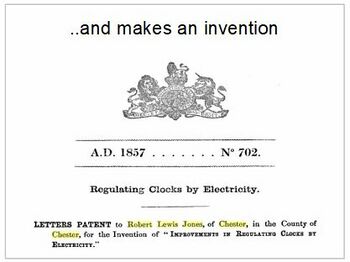
No record has been discovered of what went through Jones' mind after the inquest into the Sutton Tunnel accident. One of the criticisms that he could deal with was that of poor time-keeping at Chester Station. As noted the main station clock was not visible from the platforms and therefore Jones' logical course of action was to install some form of "repeater" clocks that could display the time throughout the station. The problem that he faced was how to synchronise these clocks with the the main clock. Earlier attempts had been made to control clocks by electricity, and had met with some success and Jones improved upon these earlier inventions with developments of his own. Jones certainly did not invent the electrically powered clock, as clocks of that type had been on display at the Great Exhibition and ticking away even while the Sutton accident was occuring. It was only in 1852 that Greenwich Time was fed directly into the Railway Telegraph system by means of a wire from Greenwich to Lewisham.
Jones invention was concerned with how an electrical signal could be used to synchonise several remote clocks to tell exactly the same time as a "master" clock. Again, this in itself was not a new idea, but Jones' system had the advantage that the remote clocks could run independently and need not be continuously governed by the "master" clock. His experiments were performed using the large public clock on the frontage of Chester Station as the "master" to control other clocks within the station, so that all told the same time, and thus, that the same time was available reliably to all of the station staff. The result was that he filed a further patent (No. 702 of 1857) which related to the regulation of clocks by electricity.
Jones development in horology is described in "ELECTRIC CLOCKS" as follows:
- "Mr. R. L. Jones, the station master (sic) of Chester, evolved the idea of sympathetic pendulums by simply applying Bain’s electro-magnetic pendulum bob to existing key-wound clocks. His Patent, No. 702, of 1857, claims the obvious advantages of perfect synchronisation, of independent life in case of electrical failure, and small current consumption. He applied it with success to his own turret clock at Chester and to a turret clock in the Victoria Tower in Liverpool. Then Mr. F. James Ritchie, of Edinburgh, took hold of it and supplied many observatories with pairs and triplets of sympathetic pendulums. In 1873, Ritchie carried it a step further. Realising what a very small expenditure of electrical energy was required to keep two tuned pendulums in phase, he was tempted to dispense with the spring or weight-driven maintenance with its merit of independent life, and drove the hands from the pendulum as Bain had done in his earliest earth-driven clocks, but by an improved method which may be described as a reversed gravity escapement."
The details of Jones' mechanism may be understood from the published specification of his patent, and in particular the figure. In his preferred system the pendulum of the "master" clock is arranged to make a momentary electrical connection at the limit of its swing. This provides an electrical pulse which passes down a wire to at least one other "slave" clock. The pendulum of the otherwise standard "slave" clock is not a conventional "bob" but has been replaced by a weight and a coil to which the electrical pulse passes. As the coil swings it passes a magnet which normally has little effect on it, but when an electrical pulse arrives the coil itself breifly becomes an electromagnet and this creates a momentary force on the pendulum. The continued application of this small force at repeated intervals will cause the two clocks to beat in synchrony.
Jones may have been a versatile fellow but he was no clockmaker and it is likely that he was assisted by someone in developing his electrical clock system. One possible candidate is Thomas Moreland, a Chester clockmaker who also appears to have been involved with the early development of the railway in Chester (see: Railway Times: Volume 2). Moreland (who is described as "a character" in the Cheshire Sheaf) had a workshop near the station in Brook Street (according to Hemingway's "Poll Book") and is known to have made at least two clocks for the booking office at Chester Station. Moreland later moved to Northgate Street. Moreland's other clocks in Chester included that on the Market Hall and the clock on St John's Hospital. He also made the Christleton church clock.
Jones and Hoole
Jones lived at "Brook Lodge" in Hoole, which is next to "The Grange" and behind the "hearing shop" at the north end of Hoole Bridge. The building had previously been the home of the Broster the Chester Bookseller and the author and publisher of an early guidebook to Chester. Hemingway describes it as:
- "a picturesque cottage, in the neat village of Flookersbrook .. an object well worthy of notice from the quantity of ancient carved work which it contains".
Towards the end of this article another perculiar connection between Flookersbrook and communications will become apparent.
A Jones Gallery
Chemisty Lock at Canalside;
Hilbre: the second thread
Signal and shipping beacons are known on the Wirral from early times. In 1588 a beacon was set up at Bidston, and much earlier the Earl of Chester Ranulf de Blondeville had set up a beacon in 1220 as the "Everton Beacon". In 1804, during the Napoleonic wars, when the French broke the blockade of Toulon, the Admiralty established a number of signal stations between Liverpool and Holyhead. An "alarm beacon" on Bidston Hill was set up at the same time. The Lancaster Gazetter reported:
- "A fire beacon is erected, a few paces to the southward of the Bidston Light-house, for the purpose of communicating the approach of an enemy, should any appear on this part of the coast"
Even the Romans took care to maintain good communications along the North Wales coast between their fortress at Deva (Chester) and their naval base at Caer Gybi (Holyhead).
Liverpool
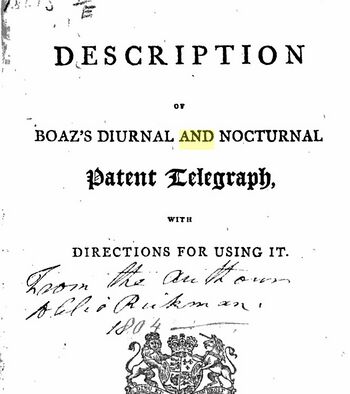
The coastal signals stations appear to have been located at Liverpool (St. Domingo in Everton - incidentally the patron Saint of astronomers), Bidston Hill, Point of Ayr, Cabe Hill, Great Orme’s Head, Point Lynas and Holyhead. There was no signal station on Hilbre Island as part of that early chain and very little is known about the nature of the signaling used. It may well have been that the only thing that the Admiralty had in mind was a simple signal that an enemy flotilla or even fleet had been sighted. Then, the July 1804 issue of the Scots Magazine mentioned:
- "A plan of a Telegraphic Establishment for Domestic and Commercial Purposes having been suggested some time since to Mr Boaz, the ingenious patentee of a Day and Night Telegraph, that gentleman has lately submitted proposals for a local experiment to the inhabitants of Liverpool. A line of Telegraphs is in consequence about to be established from Liverpool to Holyhead, for the purpose of announcing the arrival of ships bound for Liverpool, and of procuring pilots. Another line has been suggested, from Liverpool to Hull, through Manchester and Leeds; and another from Liverpool to London, thro’ Chester and Birmingham"
James Boaz (an accountant and founder member of the Philosophical Society of Glasgow) filed his patent on Dec 3rd 1801. He was elected secretary of the Philosophical Society in 1804 and remained as secretary to that society until his death in March 1830. The Society Journals say of him:
- "The presidents were often chosen annually the secretaries have however been more permanent office bearers. Mr James Boaz continued in the office of secretary from 1804 till his death in March 1830. His minutes are written with great neatness and contain abstracts of papers and drawings of models or plans which have accompanied descriptive communications." (Proceedings of the Royal Philosophical Society of Glasgow, Volume 1)
He was not to be the only person to claim to have been the original "inventor" of the Holyhead-Liverpool telegraph.
Lieutenant Morrison - aka "Zadkiel"
1833 saw the issue of "A copious report of the Inquiry into the Affairs of the Corporation of Liverpool, before His Majesty's Commissioners ... commenced on the 4th and ended on the 30th November, 1833". This was essentially a corruption enquiry and involved Sir John Tobin (see below) and other members of the Liverpool Corporation. The report is lengthy but contains some interesting comments on the semaphore. On the seventh day of the Inquiry Lieutenant Richard James Morrison (RN) gave evidence to the effect that there were serious irregularities in the operation of the semaphore telegraph. These included charges made by the corporation that were not in the accounts, payments to Lieutenant Watson (see below) that were also not recorded and, most surprisingly, he (Morrison) had originally suggested the telegraph in July 1830 and that Watson had used his plans without any payment at all. Apparently, Morrison had repeatedly tried to have these matters investigated but was either ignored or rebuffed. The inquiry did uncover clear evidence that Morrison had approached the corporation in 1830, and suggested detailed plans for the semaphore, which were apparently used by Watson, but the matter was not taken further.
Morrison turns out to be an interesting character - again well known at the time and since largely forgotten. He was born 15 June, 1795 and after a moderately distinguished career left the fighting arm of the navy. His last appointment was to the Coast Guard, in which he served from April, 1827, until Oct. 1829, when he was "under the necessity of resigning from the effects of ill health, induced by the exposure he had suffered in rescuing 4 men and a boy from wreck in the month of Feb. 1828". His exertions on the occasion were acknowledged by a medal from the “Society for the Preservation of Life from Shipwreck.” He then devoted himself to the study of astrology and in 1831 issued "The Herald of Astrology", subsequently known as "Zadkiel's Almanac" after his psuedonym, Zadkiel (צָדְקִיאֵל). In this annual pamphlet (eventually published until 1931), Morrison and his successors published predictions of the chief events of the coming year. In the 1861 Almanac Zadkiel predicted ill-health for the Prince Consort and Albert obligingly died of cholera that year, doing nothing but good for the Almanac's sales. However, the Almanac was the well-known subject of satire, with Blackwoods publishing as a parody:
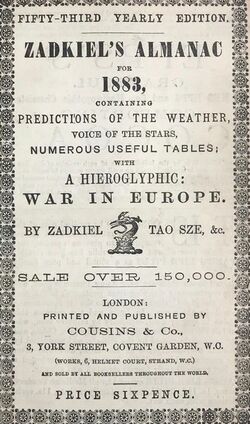
- "Blackwood's Comic Zadkiel; An Almanac at once Prophetical, Quizzical and Physical, Ombrological and Symbolical, Astronomically Comical, and Comically Astronomical, for the Year 1855: A Work Devoted to All the Ologies Except Tautology, and Containing Full Prophecies upon Everything which Nobody Wishes to Know; and Truthfully Foretelling Every Future Event, from the Winner of the Derby to the Next Revolution in the Wheel of Time."
Morrison died on the 5th of April 1874. Even after his death ridicule continued - somewhat jokingly The Athenaeum (16 May 1874, p. 666) noted that Morrison was:
- “the restorer and Grand Master in this country of Tao-Sze, a secret society intended to be of immense power, and to outshine the Freemasons, but which, most probably, by his death, is reduced to two members."
The "Tao-Sze" were apparently a Chinese secret society dating back hundreds of years - they are actually mentioned by Marco Polo in 1300. In actuality "Tao-Sze" is traditionally regarded as the founder of Taoism, intimately connected with the Tao Te Ching and "primordial" (or "original") Taoism. Perhaps his association with such matters was sufficient for Morrison's evidence at the inquiry to be discarded and his claim dismissed. Morrison had not even been original in his choice of name, the same "Zadkiel Tao-Sze" pseudonym had been used by William Lilly (1602-1681) who in 1644, during the English Civil War, published the first of his many popular astrological texts. In early Victorian times there was still a strong link (at least in the public mind) between astrology and weather forecasting. For a while "weather prophets" such as Morrison, who also had some scientific knowledge meant that weather forecasting was a mix of science and superstition.
The Semaphore Line
On 15th November 1828 the Trustees of Liverpool Docks acquired the lease to the islands and established Hilbre Island as a telegraph station in a chain for communicating semaphore messages from Holyhead to Liverpool. The original proposal was for a site at Hoylake, but Watson preferred Hilbre. It appears that the lease to the "Mease or Celle called Hilbre" was acquired from "the executors of" Dr Trevor the absentee rector of West Kirby. Trevor apparently became rector in 1803 and died in 1827. Things then got rather complicated: Dr Trevor was succeeded in 1827 by a Dr Edward Coplestone (appointed Dean of Chester just the previous year). He appeared once in the church, and read himself in. He received a year's tithe, and was shortly after made Bishop of Llandaff. Upon his promotion the Crown presented Dr. George Murray in 1828, when the same proceedings were gone through; but upon being made Bishop of Rochester, he also resigned in 1829. Overall, the rectors appear to have been absent for much of the time. Liverpool actually purchased Hilbre island in 1856.
The fact that one semaphore station was set squarely in the mouth of the River Dee may of itself have been designed both to gather commercial intelligence about what was going into Chester and to lure ships into Liverpool. Survey and construction of the complete semaphore line was, in 1825, entrusted to ex-Army Lieutenant Barnard Lindsay Watson (26 Dec 1796 – 1865). He was made Ensign in the Oxfordshire Local Militia on 13 Apr 1813, and Lieutenant on 3 Nov 1820. Given that the army was shrinking after the end of the Napoleonic Wars he was probably retired on part pay fairly soon afterwards as he was very soon working as a schoolmaster. Watson went bankrupt three times: in 1831, while a flag manufacturer in Liverpool; in 1842, again a flag manufacturer, but now in London and Kent; and finally as a hotel keeper in Bathwick, Somerset in 1848. Watson would have been aware that the best weather was often found along the coast. The line of stations ran, from Holyhead, through Llanfaethlu, Point Lynas (North Amglesey), Puffin Island, the Great Orme, Llysfaen near Abergele, Foryd, Voel Nant above Prestatyn, Hilbre Island (a second choice after Hoylake) and Bidston Hill and the final station in Liverpool.
There is an excellent book on the Holyhead-Liverpool telegraph: "Faster than the wind" by Frank Large (1998): ISBN 09521020 9 9. It is apparently out of print, but copies may be obtained from second-hand sellers online. The publishers (Avid) specialise in marine titles.
Semaphore (usually said to have been realised by Claude Chappe in 1801 - who also named it) was the Internet of its day. It is parodied as "The Clacks" in the "Diskworld" novels of the late Terry Pratchett. Use of false semaphore signals to provide "fake news" was a plot element in Alexandre Dumas' The Count of Monte Cristo (1844), where it is used to manipulate financial (bond) markets and gain revenge for the escaped Count. It has been suggested that during 1790–1795, at the height of the French Revolution, France needed a swift and reliable communication system to thwart the war efforts of its enemies. France was surrounded by the forces of Britain, the Netherlands, Prussia, Austria, and Spain, the cities of Marseille and Lyon were in revolt, and the British Fleet held Toulon. The only advantage France held was the lack of cooperation between the allied forces due to their inadequate lines of communication. In the summer of 1790, the Chappe brothers set about devising a system of communication that would allow the central government to receive intelligence and to transmit orders in the shortest possible time. The British Admiralty soon became interested in the French system and gathered useful information simply by walking up to the semaphore towers and engaging their crews in casual conversation.
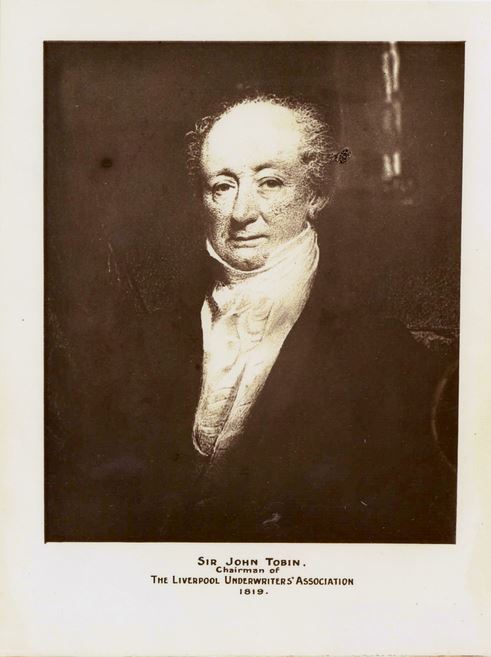
Faster than the wind
The 1825 Holyhead-Liverpool line was the first commercial semaphore line. The system enabled the sighting of a ship off Anglesey which "made her number" (with flags) to be transmitted to Liverpool within minutes. The same was true of weather changes - which could take at least an hour to be felt in Liverpool after a change at Holyhead, and vice versa. One Liverpool newspaper stated that it was "Faster Than The Wind". Knowledge of incoming ships had many commercial advantages as the process of selling the cargo and arranging the next voyage could then start. There was also a very active marine insurance business in Liverpool and the knowledge that a ship had successfuly crossed the Atlantic and was (almost certainly) about to arrive safely meant that money was freed-up for new risks. In the absence of such news of an overdue vessel, an underwriter might have to cover his potential losses by re-insurance: a very expensive measure. Typical sailing time from Holyhead to Liverpool was around 18-24 hours - but in adverse weather it could take a week. A yet further advantage of the telegraph is illustrated by the following example taken from "The Handbook of Communication by Telegraph":
- "The Brig TINLEY, with a cargo of Timber, arrived off Point Lynas; before taking a Pilot on board, she made her number, and heaving-to, telegraphed as follows:- 4.519 (Inform the) 5.688 (Owners) 7.933 (I wait for orders). This was instantly sent through the line of stations to Liverpool and was directly communicated to the Owners, who having sold her cargo in Wales, the following was telegraphed to the Brig: 6.871 (Proceed without delay to) 9.182 (Beaumaris) - and she directly made for that port which was under her lee. Vessels calling off Holyhead have frequently been directed to proceed to the Clyde, Belfast, Dublin &c "
The system was also of benefit to the captains of vessels, as they could raise flags at Holyhead and have a pilot and instructions awaiting at Point Lynas, where pilots for Liverpool were taken up and put down. Captain, crew and owners all might well prefer Liverpool's Pilot, with up-to-date weather and knowledge of at times treacherous (but well-lit) passage, to a Dee pilot. As had been stated as early as 1765 (in the previous year alone eighteen ships were stranded and 75 lives were lost.):
- "The entrance to the port of Liverpool is very dangerous without a skilful pilot, and many ships and lives have, of late years been lost owing to the negligence and ignorance of persons taking upon them to conduct ships and vessels into and out of the said Port. A proper regulation of the Pilots at the said Port and the ascertaining of their rates and prices would tend greatly to promote and encourage trade and navigation, and be a publick utility"
The record, set in clear weather during a demonstration for the Trustees in 1830, was claimed to be an amazing 23 seconds. The Welsh Coast Pioneer and Review for North Cambria (25th March 1909) mentions an even more impressive 18 seconds for a round trip. In poor visibility and at night the system was unusable. Even today (2019) it takes over three hours to take the train from Liverpool to Holyhead, a distance of over 70 miles as the crow flies. Sound travels a mile in 4.7 seconds, so even a noise which started as an incredibly loud explosion at Holyhead (say 50 tons of TNT) would take about 5 and a half minutes to cover the distance: - some ten times slower than the best working rate of the semaphore. Liverpool prospered, perhaps in part due to the semaphore, With the opening of the railway from London to Liverpool, Holyhead lost the London to Dublin Mail contract in 1839 to the Port of Liverpool. Only after the completion of the Chester and Holyhead Railway in 1850 and the building of Holyhead railway station did the Irish Mail return to Holyhead, operated from London Euston by the London and North Western Railway.
Even before the advent of electrical telegraphy the semaphore system could be used to send reasonably accurate time signals from the transit telescopes at Bidston. To do this a signal was sent back and forth along the semaphore chain several times. It was then a simple matter to calculate the time taken for the signal to traverse the chain and hence the delay which needed to be taken into account in getting a true time.
Watson's Watch
In June 1904 the Rhyl Journal reported a visit to the Voel Nant telegraphy station by the local naturalists society. During the visit it was noted that the "superintendant and adaptor" of the semaphore system along the North Wales coast was the Lieutenant Watson and that:
- "..he was the possessor of a valuable gold watch presented to him by Sir John Tobin, a wealthy Liverpool merchant of that day, as a souvenir. It appeared that one of Sir John Tobin's ships, the Mayflower" I think he was named, with a valuable cargo from the West Indies, was considerably overdue, and Sir John decided to re-insure her, and as he passed out of his office he told the clerk what he was about to do, adding that he would not be long should anyone call. He had no sooner gone than Lt. Watson called, and finding Sir John out, said to the clerk, "Oh, tell Sir John when he comes in that the Mayflower has just been reported off Holyhead." The clerk rushed after Sir John with the news, and so saved the very heavy charge of re-insuring. The watch presented to Lieut Watson, as a slight acknowledgment of the courtesy shown, had engraved on the back of it the semaphore, with the arms up tor the "Maytlower." " (it is not recorded whether the clerk got anything for his trouble)
The above story illustrates how good communications with Holyhead could be of incredible value in such a commercially active city as Liverpool. Sir John the wealthy underwriter avoids the expensive re-insurance and this kindly old gentleman is so grateful that he rewards Watson with a watch. The ship was probably simply Tobin's "May", which somehow gained the priviledge of being able to avoid dues and fees and therefore probably bore the most valuable cargo. However, there is a darker edge to the tale. Sir John Tobin (1763-1851), 'merchant', was born on the Isle of Man (his father was from Ireland). By the 1790s was a master, operating in the slave trade between Africa and the Caribbean, and operated as a privateer in the early years of the war with France. He married, 1798, Sarah Aspinall (1770-1853), daughter of James Aspinall (1729-1787), another prominent Liverpool slave-trader. It is said that 'This marriage may have brought him capital'. He was a pioneer of the palm oil trade, made money from ivory and was knighted in 1820. He became Mayor of Liverpool in 1819. According to the Liverpool Mercury - his political opponents - he paid six shillings per vote to get elected in one of "the most barefaced acts of bribery that ever disgraced even the electioneering annals of this venal rotten borough". With his ill-gotten gains he built Liscard Hall.
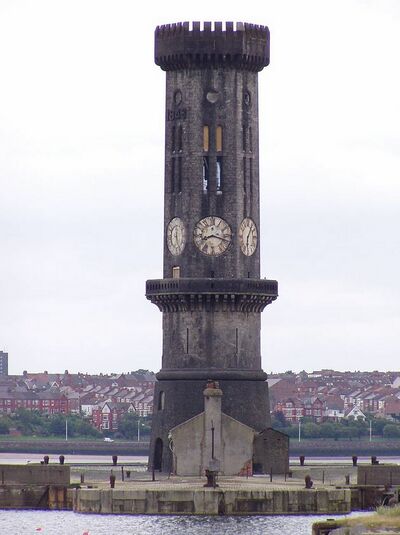
1839 was a tumultuous year for Watson. January brought the great gale of 1839, which laid waste to much of the Liverpool-Holyhead telegraph. Watson started to re-build. In the original telegraph, each station had a single tall mast with three pairs of semaphore arms, each of which could signal a digit from 0-9, and an extra indicator on top. The new telegraph had two, shorter masts, each with two pairs of arms, giving an enlarged vocabulary of 10,000 words and phrases. These included such useful phrases as "plundered of everything", "engaging pirates" and "struck an iceberg", as well as codes for cargo including onions, opium, oranges and oxen.
Around this time, in an effort to raise funds, Watson announced that only subscribing vessels would be reported by the telegraph. In March of the same year, the Hull Chamber of Commerce and Shipping commissioned Watson to survey potential sites for a telegraph along the Humber. The Liverpool Dock Committee didn’t take kindly to all this. This was not the behaviour the Trustees expected of an employee. Watson’s outside interests could no longer be tolerated. Watson had been allowed to sell his propriety flag signals to ship-owners for many years. But when the Dock Committee learned that he’d been secretly collecting intelligence for insurance companies: his benefactor Sir John Tobin was the chairman of the underwtiter's association in Liverpool. It was the last straw. In May 1839, the Liverpool Dock Committee dismissed Watson. The re-construction of the Liverpool-Holyhead telegraph was completed under a new superintendent, Lieutenant William Lord, R.N..
Magnetic: The threads come together
The British and Irish Magnetic Telegraph Company (also called the Magnetic Telegraph Company or the Magnetic) was founded by John Watkins Brett in 1850. The Magnetic was the principal competitor to the largest telegraph company in the United Kingdom, the Electric Telegraph Company (the Electric). The Magnetic was the leading company in Ireland, while the Electric was the leading company in mainland Britain. Between them, they dominated the market until the telegraph was nationalised in 1870.
Johm Brett is a somewhat mysterious figure having personally written much of what is known about him with a view to careful "news management". He appears to have at first been a well-connected art-dealer and tinkered with the idea of pneumatic railways before suddenly deciding to devote himself to telegraphy around 1845. Like many others, he lost considerable sums of money in the "Railway Mania". John Brett sold a significant part of his art collection to fund his telegraphic activities, but looking at the list of works that he claims to have sold his ownership of them can in some cases be hard to believe, although the works do appear to have included the apocalyptic "Opening of the Sixth Seal" by Francis Danby which features an entirely appropriate lightning bolt. Brett was vastly influential in the growth of telegraphy, especially when crossing bodies of water by sunken cables. John Watkins Brett died at the Coton Hill Institution for the Insane at Stafford (an insane institution built specifically for the rich) on December 3, 1863, under circumstances which are, to say the least, not well understood.
In the overall scheme of the development of telegraphy Robert Lewis Jones contribution is apparently relatively modest and appears to be restricted to the transmission of timing signals. Most if not all of the developments in telegraphy would have happened without his efforts. and his contribution should not be over-estimated. The unique thing about Jones is that he came from Chester and so it is possible to visit places that he knew in and around Chester.
Alexander Bain
Alexander Bain was born in Houstry, near Watten, Caithness, Scotland. He was baptised in the local kirk on 22 November 1810. His father was a crofter. He had a twin sister, Margaret, and, in total, he had six sisters and six brothers. Bain did not excel in school and was apprenticed to a clockmaker in Wick. Having learned the art of clockmaking, he went to Edinburgh, and in 1837 to London, where he obtained work as a journeyman in Clerkenwell. Bain frequented the lectures at the Polytechnic Institution and the Adelaide Gallery and later constructed his own workshop in Hanover Street.
In 1840, desperate for money to develop his inventions, Bain mentioned his financial problems to the editor of the Mechanics Magazine, who introduced him to Sir Charles Wheatstone. Bain demonstrated his models to Wheatstone, who, when asked for his opinion, said "Oh, I shouldn't bother to develop these things any further! There's no future in them." Three months later Wheatstone demonstrated an electric clock to the Royal Society, claiming it was his own invention. However, Bain had already applied for a patent for it. Furious conflict then broke out - Wheatstone was then Professor of Science at King's College, whereas Bain was relatively unknown. Wheatstone tried to block Bain's patents, even dragging in such noted witnesses as Brunel to testify that they had discussed clocks with Wheatstone in 1840, but failed.
When Wheatstone organised an Act of Parliament to set up the Electric Telegraph Company, the House of Lords summoned Bain to give evidence, and eventually compelled the company to pay Bain £10,000, grant him shares, and give him a job as manager, causing Wheatstone to resign.
Bain's first patent was dated 11 January 1841, and was in the names of John Barwise, chronometer maker, and Alexander Bain, mechanist. It describes his electric clock which uses a pendulum kept moving by electromagnetic impulses. He improved on this in later patents, including a proposal to derive the required electricity from an "earth battery", which consisted of plates of zinc and copper buried in the ground. Notably, the entire power of the clock is derived from this battery and there is not need to wind it.
In December 1841, Bain in conjunction with Lieutenant Thomas Wright RN, patented a method for using electricity to control railway engines by turning off steam, marking time, giving signals, and printing information at different locations. The most significant idea incorporated in the patent was his plan for inverting the needle telegraph earlier developed by Ampere, Wheatstone and others: instead of making signals by a pivoted magnetic needle under the influence of an electromagnet, he made them by suspending a movable coil between the poles of a fixed magnet. A similar concept appears in Sir William Thomson's siphon recorder. Bain also proposed to make the coil record messages by printing them, an idea he developed further in a subsequent patent. His telegraph was also successful abroad: "The initial Austrian Bain instruments were made by Johann Michael Ekling in Vienna, and later by the k.k. Telegraphenwerkstätte Wein, the Imperial Royal Telegraph Workshops Vienna."
- "For many years I have devoted myself to rendering electricity practically useful, and have been extensively engaged, not only in this country, but in America and on the Continent, in the construction and working of the Electric Telegraph; while at the same time, the employment of electricity in the measurement of time has also engaged my attention." - Alexander Bain, A Short History of the Electric Clocks
Bain was difficult to work with as he had a vile temper, was frequently ferociously drunk and was said to be very argumentative. He seems to have gone out of his way to give offence to potential allies. One biographer writes:
- "He was, unfortunately, intemperate to excess; contriving disputes with Wheatstone over electric clocks, with Bakewell over copying telegraphs and with Shepherd, another patentee of clocks, as well as with the Morse Syndicate in America. Bain died in relative poverty and is commonly portrayed as a Celtic martyr impoverished by class prejudice."
The Shepherd issue related to the clock at Greenwich. In 1852, the Greenwich Observatory had its own special clock installed, the Shepherd master clock. This was connected electrically to a "slave" clock installed at the gates to the Observatory and was the first clock ever to show Greenwich Mean Time (GMT) directly to the public. People would bring their clocks or watches to Greenwich and check them, and in turn used their clock or watch to check those of other people. The Observatory gate clock is still there today. Shortly after the "repeater" clock was installed Bain turned up with an accusation that it had stolen Bain's idea, demanding that Shepherd's name was removed from the clock and replaced with that of Bain.

Liverpool was the home of the “Magnetic Telegraph Company”. Magnetic had the problem that its rival the “Electric Telegraph” owned all the key patents, including those of Bain and Wheatstone. Electric had also done deals with the railways such that only they could install trackside wires. Telegraph poles could not be installed along roads or canals due to similar agreements, so Magnetic had to bury its cables, which needed water-proof cable.
Bain's clock suffered from a serious defect which Robert Lewis Jones addressed. In Bain, the "Master" clock supplied regular electrical pulses to the remote clocks which drove them continuously. Bain used an "earth battery" as his source of power, in which two masses of copper and zinc were buried in the ground. This had the advantage that no battery needed changing. Jones used "wet cells" which would need to be replaced. If the wire was broken, then the driving signal was interrupted and the remote clocks would stop. In Jones, the remote clocks were spring-wound clocks and so could run independently of the "Master" clock, which in the case of Jones' experiments at Chester was the "Turret Clock" at the station - the one later moved to it's position as seen down City Road. In other words, the "Master" clock only supplied regulating pulses and not the driving power. If the circuit was interrupted (for example when the battery was being changed) then the regulated clocks would only drift out of precise synchrony slowly and could be brought back to a precise repeat of the "Master" time when a battery change or other repairs were effected. Stray pulses induced by lightning for example would have no lasting effect. The other advantage of the Jones' system was that it avoided Bain's patent, which was controlled by the Electric Telegraph Company after 1852. "Electric" was the largest of Britain's telegraph operators and the great rival of Magnetic.
Magnetic and the Semaphore
Following the adoption of Gutta Percha after 1845, undersea cables became feasable, and by 1853, more successful cables were laid, linking Great Britain with Ireland, Belgium, and the Netherlands. After tenders proposed in 1857 (see The North Wales Chronicle and Advertiser - 17th January 1857) the Great Orme telegraph station was converted to electric telegraph by the British and Irish Magnetic Telegraph Company. Charles Tilston Bright who oversaw the laying of the first transatlantic telegraph cable in 1858, joined the Magnetic Telegraph Company in 1852.
Landlines and submarine cables connected the telegraph station on the Orme to Liverpool and Holyhead - and thence to Ireland. At first the new equipment was installed in the original Semaphore Station on the summit until it was moved down to the Great Orme lighthouse in 1859. Two years later the Great Orme semaphore station, and the others in the chain, closed with the completion of a direct electric telegraph connection from Liverpool to Holyhead. The whole conversion of the sephamore to electricity seems to have been funded by Liverpool and implemented by Magnetic. In 1853 Magnetic were successful with a cable from Holyhead to Ireland. Because of the infrastructure already in place there was now a direct link between Liverpool and Ireland. As Magnetic also had extensive infrastructure in Ireland they rapidly consolidated their Anglo-Irish business.
It is worth mentioning in passing why there was a delay in the completion of the Liverpool Holyhead electric telegraph. The cable was partly in place in 1859 when a terriffic storm struck the the Welsh coast. Two notable ships were involveded in it, the first being Brunel's SS Great Eastern which successfully rode out the infamous "Royal Charter Storm". The second was the Royal Charter herself, which did not survive. The "Royal Charter", built at Sandycroft on the River Dee, lost both anchors in the storm and was wrecked. The public impact of the shipwreck may be judged by the fact that Charles Dickens travelled from London to Anglesey to report on the aftermath as described in The Uncommercial Traveller. However, an almost footnote in the newspapers records that the Royal Charter's anchor cable appears to have damaged the telegraph cable. It is perhaps even possible that the submarine telegraph cable caused the loss of the anchor and thence of the ship.
Jones' Clocks
In 1857 the "Magnetic" company acquired the newly granted patent of Robert Lewis Jones of Chester. "Magnetic" began to use Jones' method of regulating clocks in its offices. The public appreciation of such clocks it measured from the large electric clock it had in the window of its office at Exchange Buildings, Liverpool, controlled by the Observatory at Bidston. Apparently all the clocks in the Liverpool Exchange were now centrally controlled according to the Jones system. At about the same time "Electric" installed one of Bain's clocks in the window of the "Manchester Times" and was rewarded amply with column inches of publicity. The Exchange in Manchester also possessed an electric clock in 1847, which the other newspapers diligently covered in their columns. The Company promoted them as "the Electric Clock with Perpetual Motion", as it relied on a telluric or earth battery buried deep in the ground; adding "there is not a single spring in this clock". Magnetic's "Jones" clock in Liverpool may well have been a response to this, or the other way round. On February 4, 1861 it counted the number of people who "took the time from the clock" between 6am and 5pm – the number totalled 1,860.
The Victoria Tower at the Birkenhead docks had a new clock installed and controlled in the same way, with the signals again being provided from the observatory at Bidston. Jones had his detractors. One potential technical flaw in his system is described in A Rudimentary Treatise On Clocks, Watches & Bells for Public Purposes by Edmund Beckett (1903):
- "Mr R L Jones when manager of the Chester Station, about 30 years ago, hit upon the ingenious plan of controling rather than attempting to drive a subordinate clock, by sending a current over its pendulum at every beat of the normal or governing clock. It does not matter if the current sometimes fails for a few seconds, or even minutes, unless the subordinate pendulum has time to get more than a whole beat wrong, in which the error would be augmented into two when the connection was resumed, which is a rather serious evil; and I understand this plan has been abandoned in some places which adopted it."
Of course, the "drift" of the regulated clocks only becomes a problem if they are not of a particularly high quality. If the regulated clocks normally keep time with only a small drift then the resumption will bring them back to the correct time. A well-adjusted long-case clock can be made with a typical accuracty of about one minute a week - about 1 in 10,000, so the longest interruption that the Jones system could handle without "to the second" accuracy would have been up to something less than one and a half hours. In practice, the most common interruption of signal that Jones appears to foresee is when the battery used to generate the signal at the "master" clock needs to be changed (the battery would have initially been a Daniel Cell - invented in 1836). Failure of earlier electric clock systems when the battery ran down was a long-standing problem. Bain solved this by the use of his "earth battery" which never ran down, while Jones uses electricity only to keep otherwise conventional clocks in synchrony.
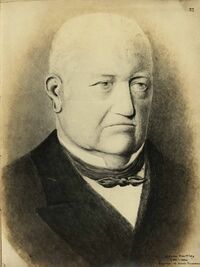
Despite Beckett's doubts we also learn that the clock in Liverpool was "attended with the most complete success" and was also proposed in Glasgow for controlling all of the public clocks in Glasgow, Port Glasgow, Greenock and Paisley after a successful trial in 1863 involving communication between the University clock on High Street and the Glasgow Horselethill Observatory. From 1859 to 1864, both visual and audio one o’clock time signals had operated in Glasgow. Although the University carried a remit to provide the city’s time, following convoluted processes of establishment, a local chronometer-maker operated a time ball for 4 years. Prior to the introduction of improvements, the setting of public clocks in Glasgow was appently a haphazard affair - one writer noted that you could set off down a street at 06:00 and arrive at the other end at 05:30.

Towards the end of the period, time guns were triggered by telegraph from the Royal Observatory Edinburgh. Both exercises caused aggravation for the University. For the ball, the Professor of Astronomy, John Pringle Nichol, failed to convince the City Council that the “drop” control should originate from the University’s Observatory. For the guns, Robert Grant, the newly appointed Astronomy Chair holder, was aggrieved by the Astronomer Royal for Scotland, Piazzi Smyth, appearing to operate above his station. Rather than having only a once per day reference, both projects were abandoned as the University laid a dedicated telegraph cable from its observatory to control many public clocks and additional clocks with large sweep fingers indicating exact time to the second. Presumably the new clock system was good enough for navigational purposes. In the discussions at the time Jones himself reported that:
- ".. a standard of accuracy of one tenth of a second had been maintained in all weathers and conditions. In addition the mechanism had been utilised for the operation of a time ball for the checking of chronometers, and that the system had been extended to include smaller clocks placed in shop windows and one at the Exchange Piazza."
The mention of the Exchange clocks by Jones himself is interesting, as several writers, inluding the Proudman Institute have only mentioned that the Exchange clocks were an example of "Henley's Electro-magnetic Clock" system. William Thomas Henley was another remarkable character - a self-taught electrician who started as a dock-porter. Jones clocks are further discussed in the Glasgow Herald of the 5th January 1864, where it is mentioned as:
- "..the ingenious invention of Mr Jones of Chester, which has been for several years in practical operation at Liverpool, where it has been attended by the most complete success."
The most striking implemetation of a Jones clock was at the Victoria Tower in Liverpool - the so-called "Dockers Clock". Victoria Tower was designed by Jesse Hartley (who also worked on the Grosvenor Bridge) and was constructed between 1847 and 1848, to commemorate the opening of Salisbury Dock. Its design was based upon an earlier drawing by Philip Hardwick in 1846. Upon its completion is also served as a flat for the Pier Master. The tower acted as an aid to ships by providing both an accurate time and also warning of impending meteorological changes. Granite from Kircudbright, sandstone and brickwork were used for the tower's construction. It's faced with ashlar granite and the doorways and windows have dressed voussoirs and quoins. The corbels, balustrades and castellations feature fine workmanship. The floors above ground are each supported by two cast iron inverted V-shaped beams. Between these is vaulted brickwork. The beams are set at angles that differ from floor to floor by 60 degrees. This spreads the load evenly. The floors are laid with clay tiles, except for the lower three floors, which have tongue and groove boarding, as these floors were the living accommodation. The fifth floor is an open belfry with a single brass bell by Mears & Stainbank of Whitechapel Foundry, London. It is dated 1892. Its six clock faces allowed sailors to make sure their timepieces were correctly set as they headed off to sea, and the bell in the tower warned of fog or high tides.
Others referred to the success of the Jones system with various degrees of accuracy in their writings, often omiting all mention of Bain. In "Old Scottish Clockmakers" (1921) we read:
- "It was Wheatstone, who, on the first introduction of the electrically-moved pendulum, suggested the idea of an electrically-controlled pendulum, which was taken up and successfully worked out by Mr Jones of Chester. Under this arrangement a standard clock is enabled by means of an electric current to regulate the pendulum motion of any number of other clocks, and so make the latter keep time with perfect precision. It is thus that the clock which fires the time gun on the Castlehill, as well as several other clocks in Edinburgh, are controlled by a standard clock at the City Observatory, and indeed, the method is now in use all over the country for the purpose of keeping public clocks up to Greenwich time."
The proposal to use the Jones system in Scotland was opposed by the abovementioned noted Victorian accentric: Charles Piazzi "Pyramid" Smyth, but then Jones' system was adopted and used successfuly in Glasgow and its ports, for 50 years until its replacement by a nation-wide wireless radio service: the Greenwich Time Signal.
To some extent the success of Jones' clock system can be seen as the consequence of the failures of Bain, who was frequently mired in law-suits and repeatedly bankrupted his investors. By 1872, Alexander Bain was working for a watchmaker at 96 Buchanan Street, Glasgow, effectively back to where he had started out in 1830. One of his customers was Sir William Thomson, Professor of Natural Philosophy at the University of Glasgow and better known as Lord Kelvin; even if they had not met previously, they would have known of each other’s work. Thomson had been knighted for his contributions to the successful Atlantic cable of 1866 and would have immediately realised this was not a fitting end for such a pioneer as Bain. With others he petitioned the prime minister, William Gladstone, for a Civil List pension, and this resulted in £80 per year being granted in July 1872. Alexander Bain died in 1877 whilst living at the Broomhill "home for incurables" in Kirkintloch, having sadly lost all of the opportunities that his electric clock had offered. It is ironic, given his fatal weakness, that the largest memorial to Alexander Bain is a drinking house in Wick, Caithness. Kelvin himself also worked on clocks and designed the highly accurate mechanism which was installed for the clock at St Paul's Boughton - partly to keep Chester's Trams on time.
Seen in overall context Bain was a more far-sighted inventor than Jones as well as a deeply flawed character. Jones provided a practical alternative which avoided the Bain patents and found fertile ground in the hands of "Magnetic". Robert Lewis Jones died on the 28 June 1892, leaving relatively little money. Looking at Lewis-Jones inventions overall, he gives every impression of being something of a "tinkerer" who worked in several unrelated fields and made no real money from any of his inventions.
Subsequent Developments
The telegraph system expanded enormously in the 1850's, both on land and underwater. The cable to France was laid in 1850 but was almost immediately severed by a French fishing vessel. It was relaid the next year. Brett started the fundraising for the Atlantic Telegraph Company's project to build the transatlantic telegraph cable at the Magnetic's Liverpool headquarters in November 1856. The first official telegram to pass between two continents was a letter of congratulations from Queen Victoria of the United Kingdom to President of the United States James Buchanan on August 16, 1858 - took sixteen hours to transmit. Signal quality declined even further quite rapidly, slowing transmission to an almost unusable speed. The cable was destroyed the following month when Wildman Whitehouse applied excessive voltage to it while trying to achieve faster operation. It would be Lord Kelvin, Bain's benefactor, who would solve the problem of effective cable operation.
There were several other attempts to lay a cable across the Atlantic and these were successful in 1866 with an improved cable laid by SS Great Eastern. Thomas Brassey of Chester had given financial help to Brunel to build his Great Eastern (orginally: "Leviathan"), which in 1854 was six times larger than any other vessel in the world. Brassey was a major shareholder in the ship and after Brunel's death, he, together with Daniel Gooch and others, bought the ship for the purpose of laying another Transatlantic telegraph cable.

Great Eastern's immense hull was fitted with three iron tanks for the reception of 2,300 nautical miles (4,300 km) of cable, and her decks furnished with the paying-out gear. At noon on July 15, 1865, Great Eastern left the Nore for Foilhommerum Bay, Valentia Island, where the shore end was laid by Caroline. This attempt failed on August 2 when, after 1,062 miles (1968 km) had been payed out, the cable snapped near the stern of the ship, and the end was lost.
Great Eastern steamed back to England, where Cyrus Field issued another prospectus, to lay a new cable and complete the broken one. On July 13, 1866, Great Eastern started paying out once more. Despite problems with the weather on the evening of Friday, July 27, the expedition reached the port of Heart's Content in a thick fog. The next morning at 9 a.m. a message from England cited these words from the leader in The Times:
- "It is a great work, a glory to our age and nation, and the men who have achieved it deserve to be honoured among the benefactors of their race." "Treaty of peace signed between Prussia and Austria."
The shore end was landed at Heart's Content Cable Station during the day by Medway. Congratulations poured in, and friendly telegrams were again exchanged between Queen Victoria and the United States. From the 1850s until well into the 20th century, British submarine cable systems dominated the world system. The telegraph had an enormous effect on three industries; finance, newspapers, and railways. Telegraphy facilitated the growth of organizations "in the railroads, consolidated financial and commodity markets, and reduced information costs within and between firms". The social consequences were immense, although some feared that the system would lead to a flood of irrelevant information and the system attracted criminals who used the networks to commit fraud, hack private communications, and send unwanted messages. One early stock-market crash, the Panic of 1857 was propagated when an over-extended mortgage lender collapsed and the news spread rapidly. In many ways, telegraphy can be seen as the Victorian internet.
In Liverpool, broker John Rew recognised the far-reaching implications of developments in telegraphy and created the "hedge fund system". By using the cable, he could get quotations from the Cotton Belt in the USA and buy the cotton at almost a moment's notice; previously, the only way to do this was via an exchange of letters, a process which took weeks. During this time, and especially during the American Civil War the price of cotton could shift quickly and significantly. After the Civil War, under Rew's business scheme, the cotton would be scheduled to arrive in Liverpool in two or three months' time. But as soon as he had bought his actual cotton, Rew could go to the "arrivals market" in Liverpool where he sold the exact quantity of cotton he had bought speculatively, selling it at a fixed price for delivery far enough ahead to cover the time it took for the cotton to arrive and a reasonable period in which to sell it. When the cotton arrived in Liverpool, Rew sold it to his spinner and bought back his speculative contract in the arrivals market. If the price of cotton had dropped, say, four pence since his purchase, Rew would have lost that amount on his cotton; but he would also have made a profit of four pence on his speculative contract in the arrivals market, which he would now enforce. This is the first example of a "hedge" - Rew would make money whether the price rose or fell. This led to the hugely successful Liverpool Cotton Futures Market.
Pickering: a co-incidence?
There is another possible link between Hoole in Chester and the development of the submarine telegraph. Charles W.H. Pickering (1815-1881) was a principal of a large international banking firm (John Henry Schroeder & Company of Hamburg). In 1860 he built his home, Montebello, in Birkenhead, England where he and his wife raised a family of 11 children and were generous patrons of the community.
In 1857 Cyrus Field visited Birkenhead and successfully enlisted the financial help of Pickering to seek funds to build his first Transatlantic communications cable and Pickering became the managing director of the enterprise in which Brett was deeply involved. At the time (1857) Liverpool was a hot-bed of telegraphic developments and one might enquire whether there is any connection between Pickering and Jones, other than the fact that there is a Pickering Street just a stones-throw from where Jones lived in Hoole.
As recorded in George Sawards history of the cable:
- "In Great Britain Messrs. George Peabody and Co., Messrs. Overend and Gurney, Messrs. Schroeder, Messrs. C.M. Lampson and Co., and the Right Hon. J. Stuart Wortley, of London; Mr. C.W. Pickering and Mr. Cropper, of Liverpool; Mr. Richard Gardner and Mr. Robert Lees, of Manchester; Messrs. Coats and Co., of Paisley; Mr. Crum Ewing and Mr. Walter Paterson, Glasgow, were among the earliest and most liberal subscribers to this undertaking at a time when the hope of profit from their venture was very remote, and the undertaking rather partook of the character of a grand philosophical experiment."
Charles Pickering had married Elizabeth Walker (1819-1895) in 1840 at Chester, she was in turn the daughter of Thomas Walker (of Flookersbrook) and Katherine Lightfoot of another Hoole familiy. Katherine's father was John Lightfoot, licensee of the Ermine Hotel and Pub from 1818-1820 The names of the families turn ip in the street names of Hoole. Pickering had also been in business with a Charles Walker as a common brewer, porter dealer and maltster, so he had close connections with Hoole where Robert Lewis Jones lived, also at Flookersbrook. It is likely that the two would have been acquainted.
Charles Pickering was present when the first official Transatlantic Telegraph message was transmitted:
- "A number of electric currents were then sent through the conductor, and the insulation was reported to be perfect, -- perfect so far as the comparatively crude means of testing were then capable of showing. The following Directors were at Queenstown at this time in attendance upon the squadron: Mr. Brooking, Mr. Lampson, Mr. Crosibe, Mr. Pickering, Mr. Logie, Mr. Brett, and Mr. Cyrus W. Field."
It was to be the message from Queen Victoria to the US president but Charles Pickering made a change and just before the Queen's message on August 5, 1858 Pickering sent:
- "Glory to God in the highest, on earth peace, good will towards men".
The story of Pickering's message is reported by his son (in his memoirs) who wrote:
- "The message from Queen Victoria to the president was handed to the telegraph operator, a Mr. St. John .. The telegraph operator told me later that my father put his hand on Mr. St. John’s shoulder and told him to stop. My father told him there was a message to be sent before the queen’s telegram."
Whether Pickering actually sent the message is only evidenced by his son, but the fact that the message was sent by one of the directors is evidenced by a later enquiry into cables which reports the entire traffic and indeed places the message just before that of the Queen, and we know that Pickering was present. Events then descended into something of a farce, which may have fogged the history of events somewhat. The British were unable to get a repeat of the Queen's message back as the cable had been damaged. Wildman Whitehouse eventually obtained a clear version of the message using the sensitive detecting apparatus invented by Lord Kelvin, but then had this transferred to the punched-tape output of his preffered appararus - his own invention. Wildman's gadgetry needed a far higher current than that of Kelvin, so Wildman used thousands of volts on the cable which apparently soon wrecked it. The parties believed that the return message had been sent successfully and the exchange of telegraphs between the Queen and the President was announced prematurely, leading to some speculation that it was part of a stock fraud. Whitehouse was sacked and an investigating committee (of which Pickering was a member) placed the blame for the loss of the cable on him. Some modern theories place the blame on manufacturing techhniques used and believe that Wildman was a scapegoat and the cable would have soon failed anyway.
Summary
It is a peculiar co-incidence that both Robert of Chester (around the time of Henry IV) and Robert Lewis Jones (a Victorian) should be interested in both inks and time-keeping. Driven in part by the railways, Greenwich time, about which Bain had protested, spread around the world. The erection of clock towers in India suggests the way in which clocks became a self-conscious symbol of British identity. The first clocktowers were built in India in the 1860s, after the Sepoy Mutiny of 1857. They were meant to remind onlookers of the power of Britain as an imperial ruler and in at least one formerly rebel controlled city, Aligarh, a 13th century military memorial pillar was pulled down in 1862 and replaced with an "imperial" clock tower - a typical example of a "Ghanta Ghar" as found throughout India and Pakistan. In fact, the imposition of imperial time in India would later lead to strikes and riots as it disrupted the local cultural adherence to solar time.
Virginia Woolf writes in "Mrs Dalloway" (1925) of "time ratified by Greenwich" and her 1922 book "Jacob’s Room" offers an ambivalent reflection on the clock as a technology of progress and abstraction. James Joyce's writings (1918) have Leopold Bloom ponder on the "clock worked by electric wire from from Dunsink" (apparently Dunsink Observatory was at one time using the Jones system). Both treat such regular time as a thing worth noting - although GMT had became the "official" time on 2nd August 1880 - except in Ireland, which used Dublin Mean Time until 1916. But absolute time was not to last, Einstein would show that all time was, somewhat like local solar time, relative. Nowadays even this local variation of absolute time needs to be taken into account for navigation.
As the timeline below shows, Jones' invention comes just after many of the important developments in timekeeping, telegraphy and the railways, however he provides an interesting local reference point for the rapid technical developments during his life.
A Jones Chronology
- 1804: James Boaz makes his suggestion of a commercial telegraph;
- 1806: Robert L Jones born;
- 1807: Slave Trade outlawed;
- 1810: Jones Snr operating oak chemical plant at Canalside, Alexander Bain born;
1820's
- 1825: Barnard Lindsey Watson appointed to the Liverpool Holyhead Semaphore;
- 1826: Menai Bridge opens;
- 1828: Dock Trustees lease Hilbre Island;
- 1829: Mail service moves from Holyhead to Liverpool;
1830's
- 1830: Liverpool and Manchester railway opens, it takes two days to travel from Chester to London by mail coach;
- 1832: Samuel Morse begins working on telegraphy;
- 1833: Inquiry at which Morrison (Zadkiel) claims to have invented the semaphore telegraph. Grosvenor Bridge completed;
- 1836: Chester (finally) abolished tolls at the city gates;
- 1838: First commercial railway telegraph in Britain;
- 1839: Storm wrecks much of semaphore; Watson dismissed, the train journey from Liverpool to London becomes possible in less than nine hours;
1840's
- 1840: Bain demonstrates his electric clock models to Wheatstone, Chester-Crewe railway (and Crewe works) opens, Chester-Birkenhead railway opens;
- 1841: Bain files his first patent on electric clocks;
- 1845: Brett becomes interested in telegraphy, murderer John Tawell arrested after telegraphic note sent;
- 1846: Jones becomes General Manager of forthcoming Chester Station, patent granted on lamp black, railway shares peak, Chester-Shewsbury railway opens;
- 1847: Dee Bridge Disaster. The BL&CJR takes over the financially troubled Chester and Birkenhead Railway;
- 1848: Chester General Station completed; Dockers clock tower completed, Chester-Holyhead railway opens;
1850's
- 1850: Delayed route from Chester towards Warrington finaly opened. Cable run from Britain to France by Brett;
- 1851: Sutton Tunnel railway accident;
- 1852: Public GMT clock installed at Greenwich, Bain sells his patents to "Electric";
- 1853: "Magnetic" lay first cable from Ireland to Holyhead;
- 1854: Morse wins major patent case in US;
- 1855: Electrically controlled clocks installed at the Liverpool Exchange:
- 1856: Liverpool Dock Board purchases Hilbre Island;
- 1857: Jones patent on electric clock system filed and granted: patent aquired by "Magnetic". First attempt at transatlantic cable (Cyrus Field) fails, share price panic in US spreads by telegraph;
- 1858: First transatlantic cable is successful (barely), but fails in September;
- 1859: Jones system installed at Liverpool "Dockers Clock"; "Royal Charter" storm - the anchor of the eponymous ship apparently damages the cable before the ship is lost;
1860's
- 1861: Liverpool-Holyhead Semaphore becomes an electric telegraph, US Civil War starts - the telegraph is used by both the Union and Confederate forces during the war;
- 1862: Jones clock system installed in Glasgow;
- 1863: Brett dies (in asylum)
- 1865: US Civil War ends, another attempt at laying the transatlantic cable fails;
- 1866: Liverpool Observatory moves to Bidston. Second successful transatlantic cable;
- 1867: One-O-Clock gun starts in Liverpool;
1870's and after
- 1877: Bain dies (in asylum);
Related Pages
- Canalside: a walk along the canal from Chemistry lock;
- Chester Station: a history of the station and some railway incidents in Chester;
- Clockmakers: public clocks in Chester and the makers of these and other clocks;
- Hilbre Island: more on the history and ecology of the islands;
- Tanning: a brief look at the history of Tanning in Chester and the allied trades;
- Hoole: where Jones lived;
Sources and Links
Books
- ELECTRIC CLOCKS: Bain's own book (1852) on the subject;
- ELECTRIC CLOCKS: mentions Jones, briefly;
- CHAMBERS ENCYCOPEDIA: on Jones;
- ELECTRICITY: has section on Jones;
- JUROR'S REPORT: from the international exhibition of 1862 - Magnetic and Jones;
- A Rudimentary Treatise On Clocks, Watches & Bells for Public Purposes by Edmund Beckett (1903);
- Reflections on the Astronomy of Glasgow;
- Jones Patent;
- Parry's Railway Companion: from Chester to Holyhead;
- The Navicula Sundial:
- The Astrolabe and Medieval English Life:
- IMPROVING INSTRUMENTS : EQUATORIA, ASTROLABES, AND THE PRACTICES OF MONASTIC ASTRONOMY IN LATE MEDIEVAL ENGLAND;
- Robert of Chester: - some works with a useful introduction;
- John Westwyk: the true author of the "Chaucer" treatise on astrolabes;
Sutton Tunnel
- The North Wales Chronicle and Advertiser for the Principality: news report;
- Accident Report;
- Disaster on the Chester Cup Excursion, 1851: from Cheshire Magazine;
- Britain's Railway Disasters: Fatal Accidents from the 1830s to the Present Day;
- The Law Times, Volume 17: note the number of railway bills in parliament;
- The Dee Bridge Disaster: 1847;
- EARLY BRITISH RAILWAY TUNNELS: The implications for planners, landowners and passengers between 1830 and 1870;
- TRAIN SIMULATOR!: Sutton Tunnel is at 18:10;
Alexander Bain
- "Distant Writing" on Alexander Bain;
- More on Bain:
The Docker's Clock
- description and photographs:
- some remains of the clock:
- Dunsink Time: appears to be a Jones Type connection;
Cables
- The Telegraph - History of the Atlantic Cable & Undersea Communications: from the first submarine cable of 1850 to the worldwide fiber optic network;
- Friends of Bidston Hill;
- Bidston Beacons;
- "Time and Tide" at Bidston;
- CHARLES WILLIAM HARRISON PICKERING;
